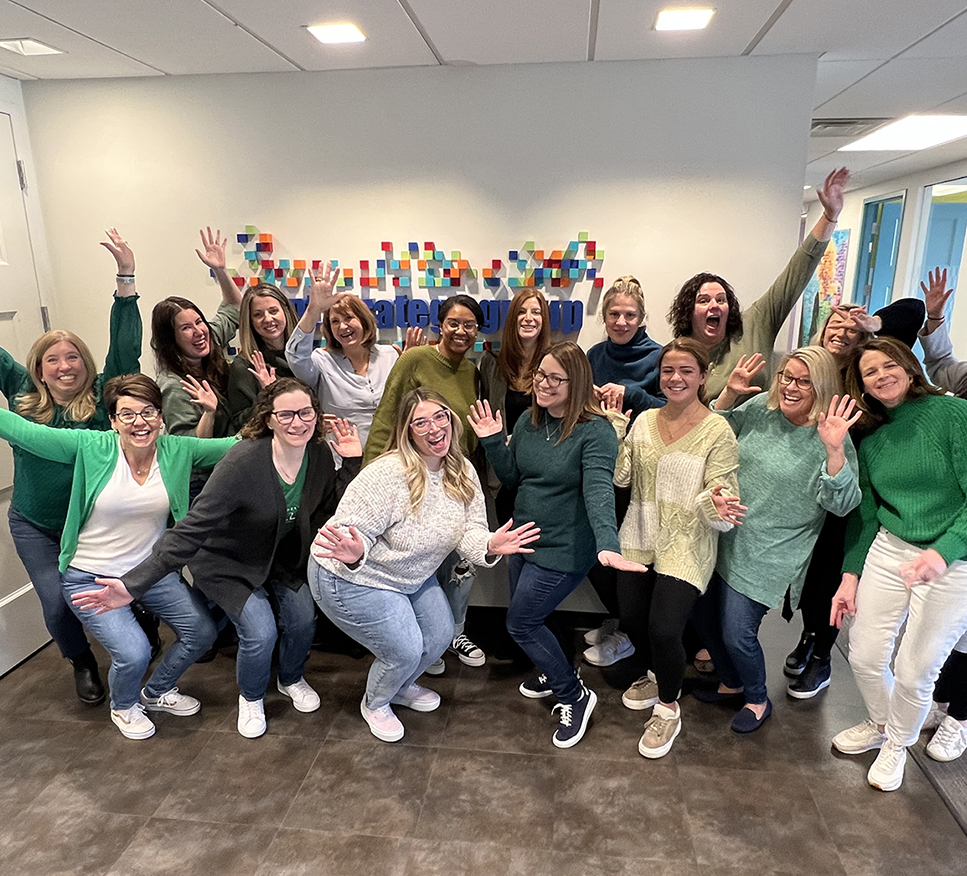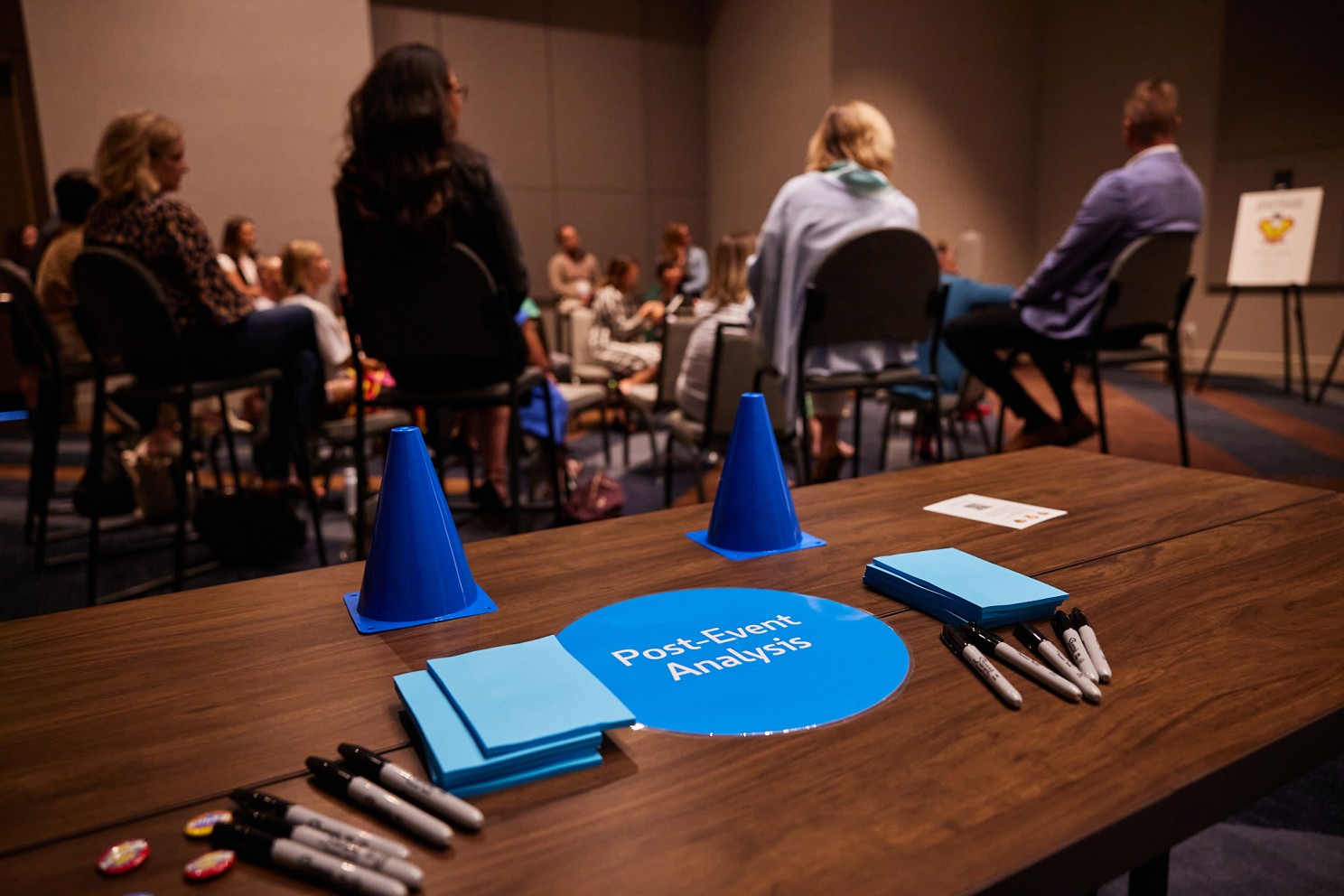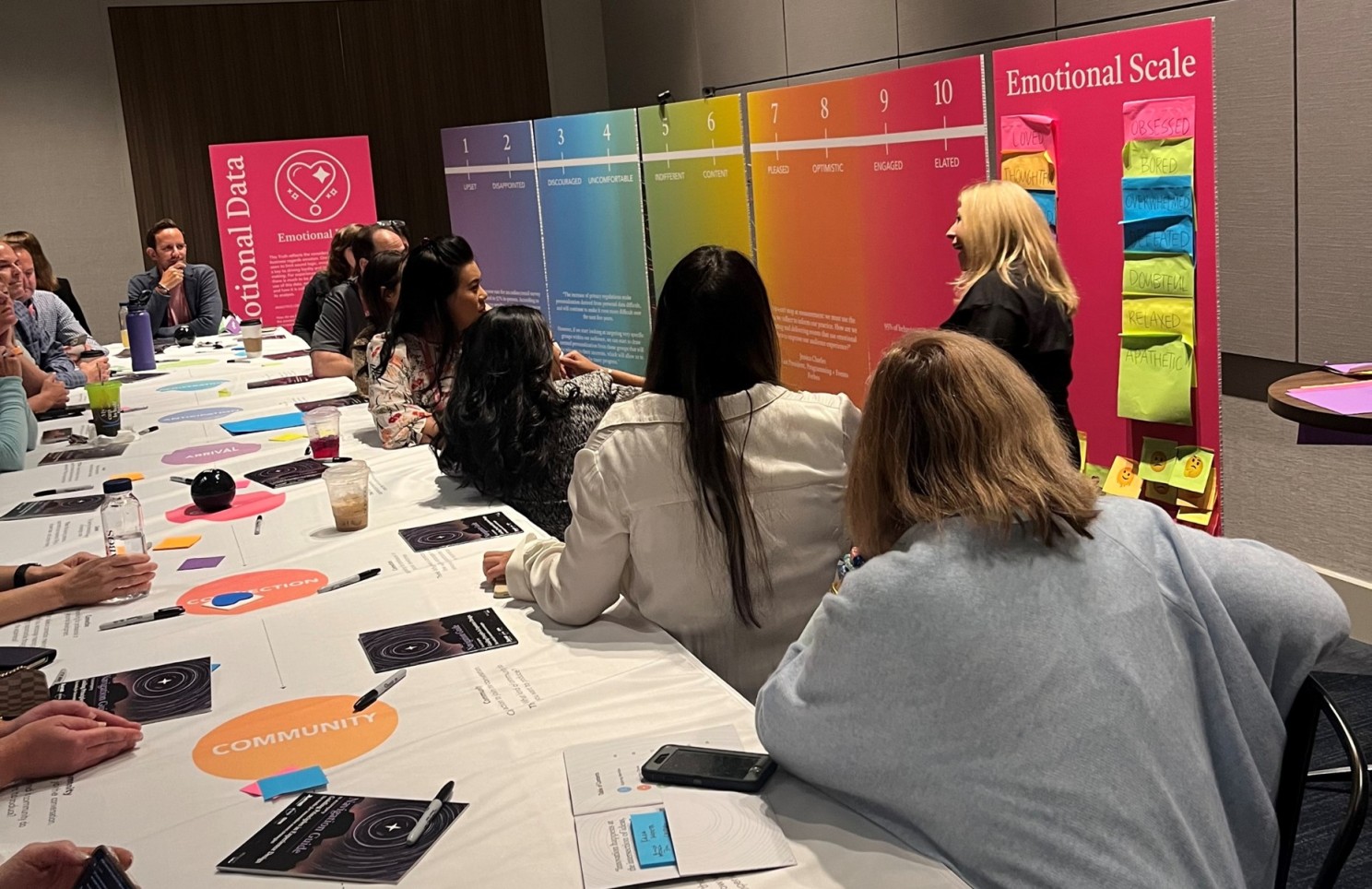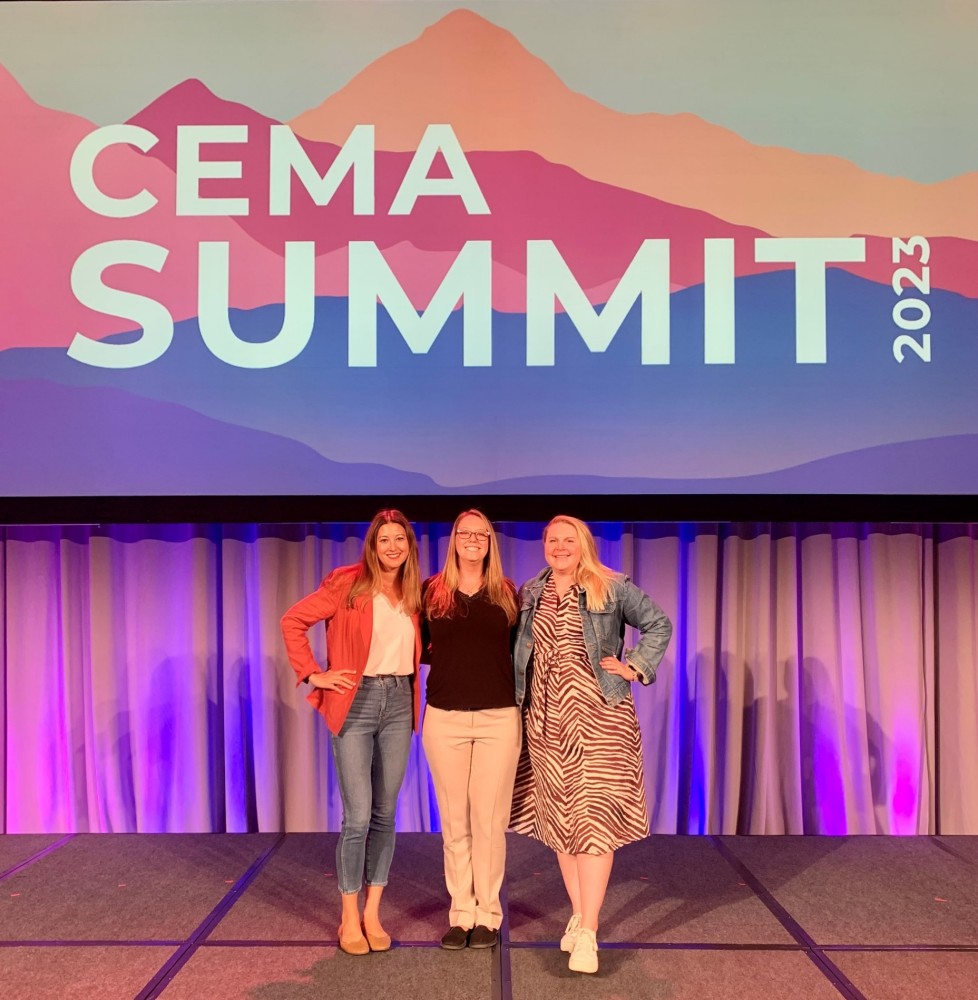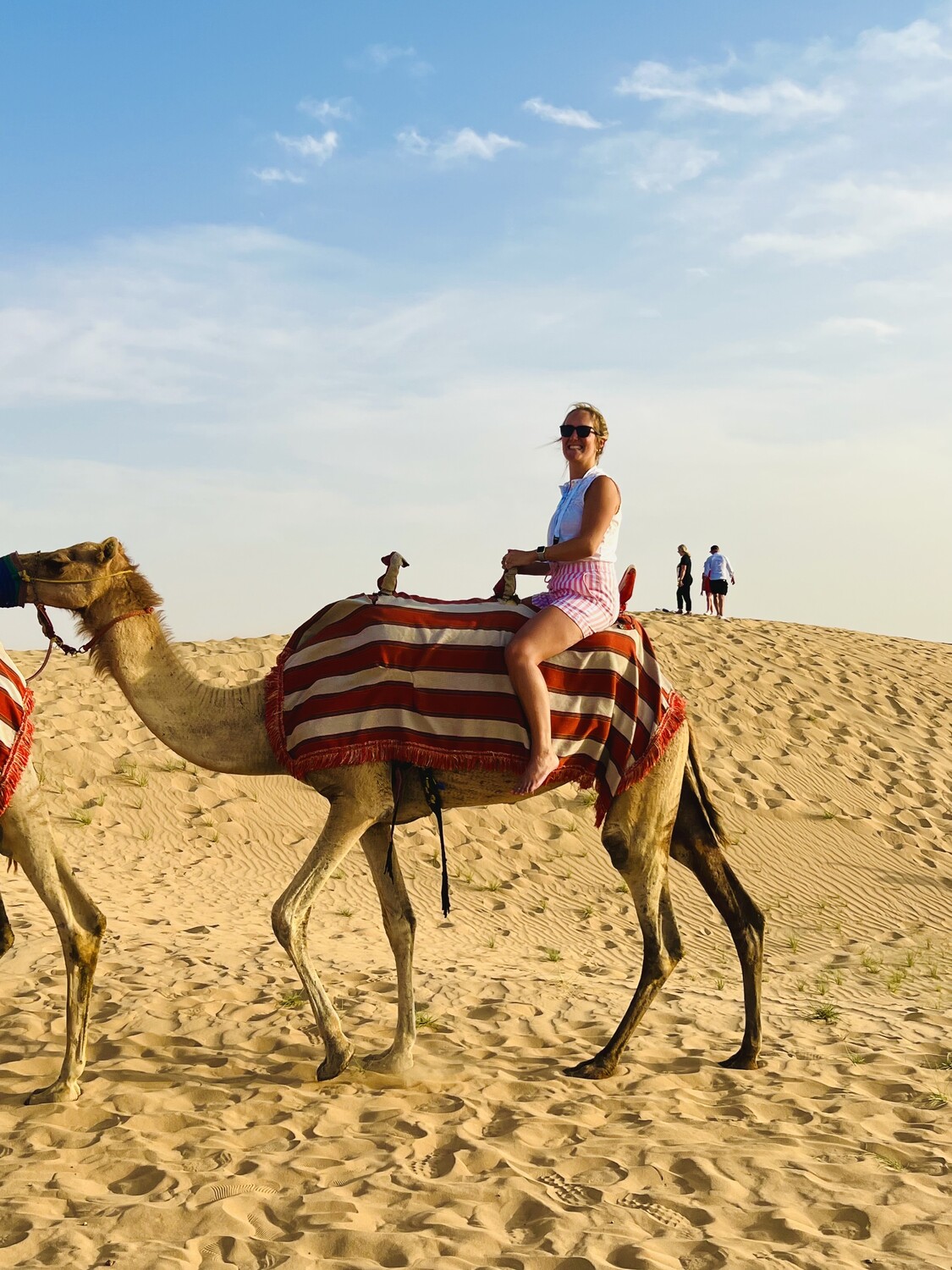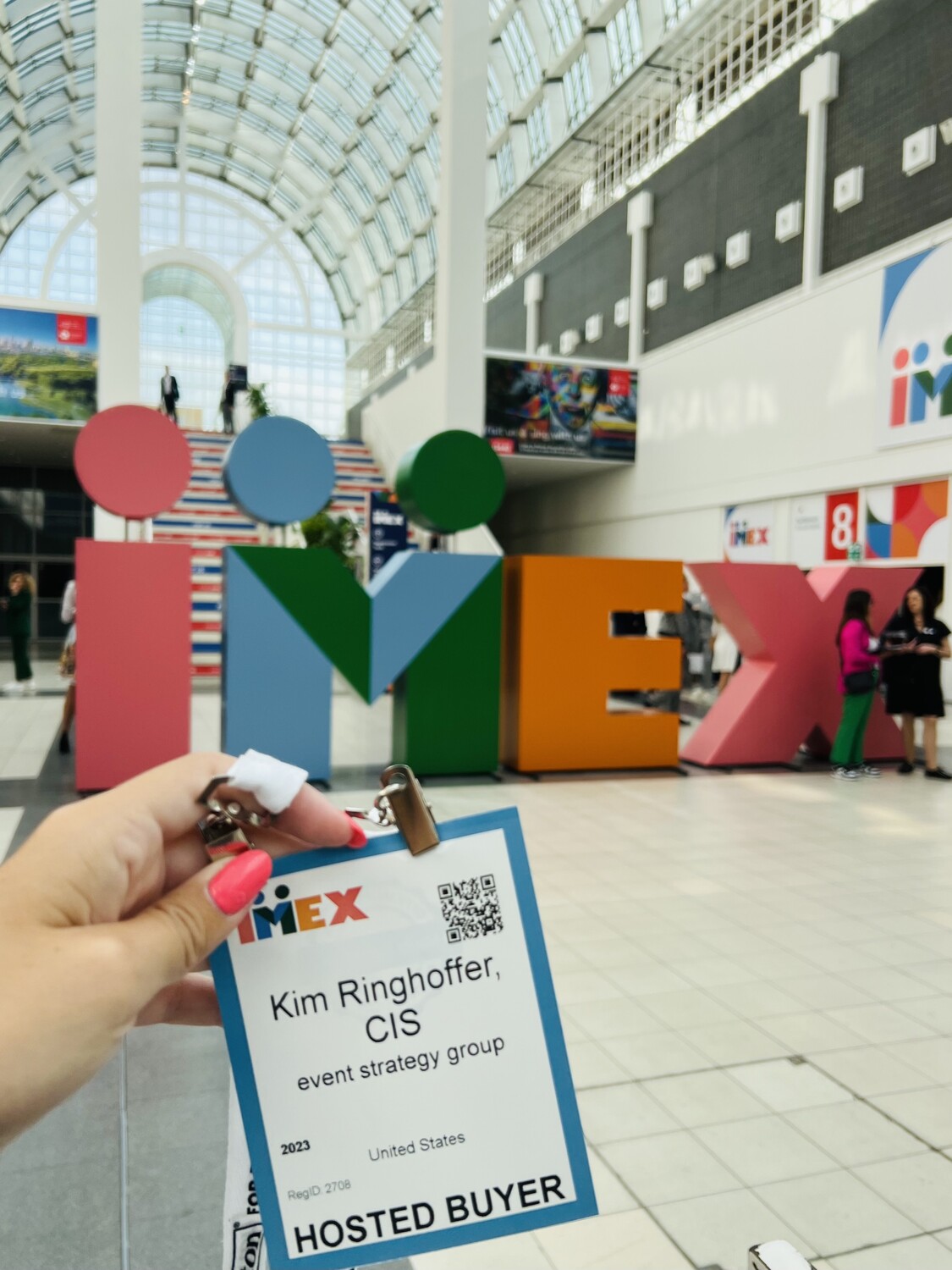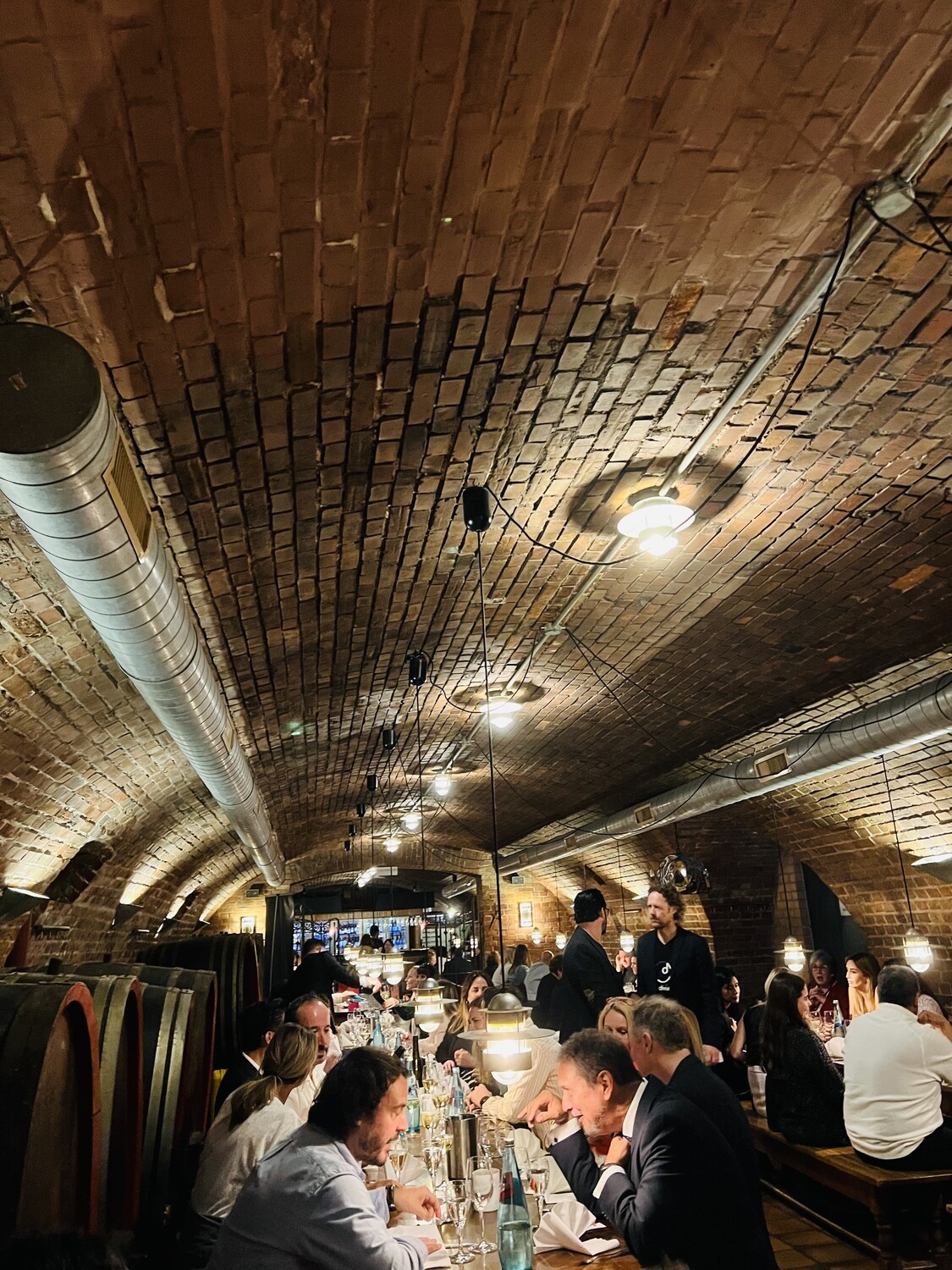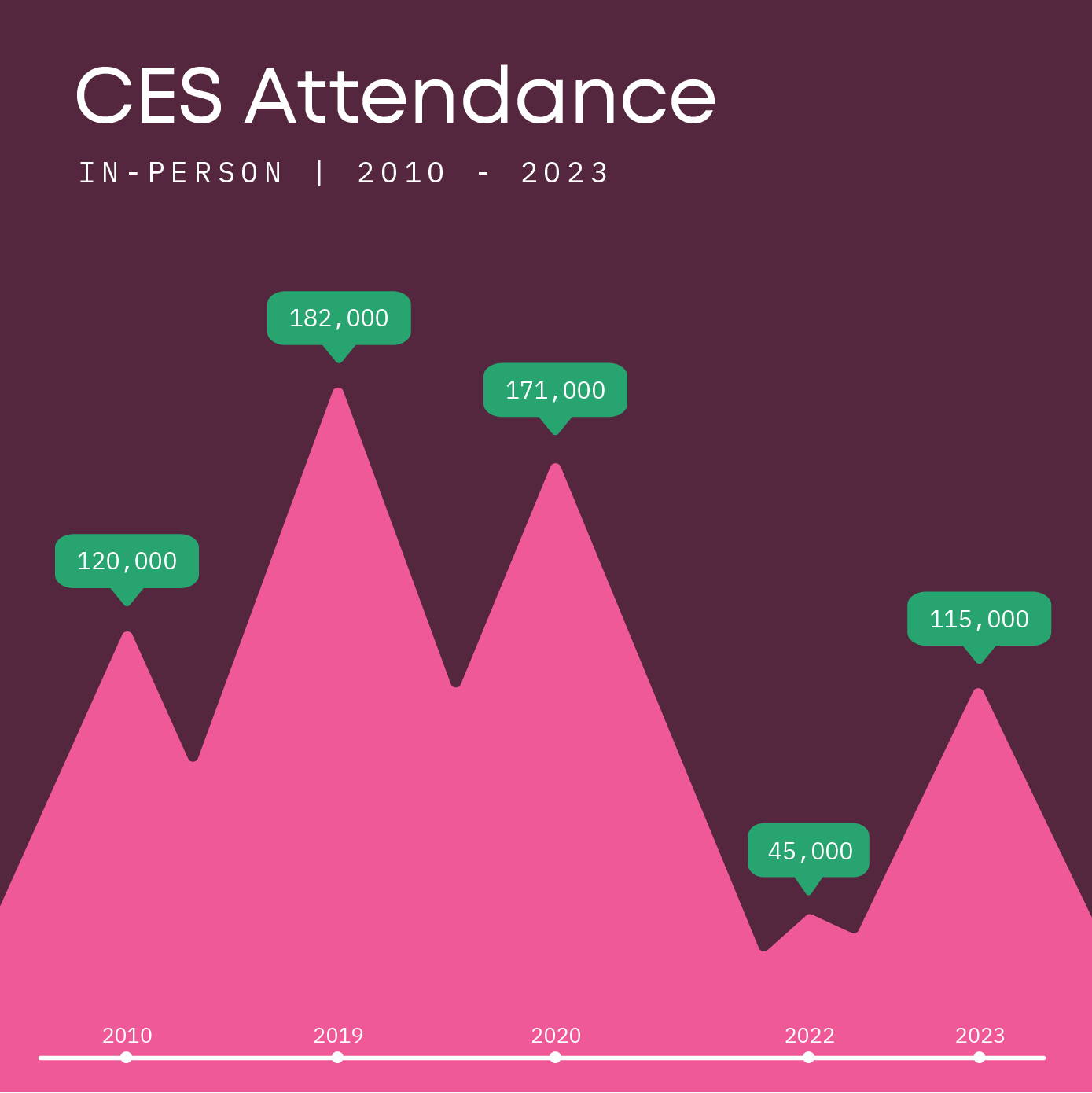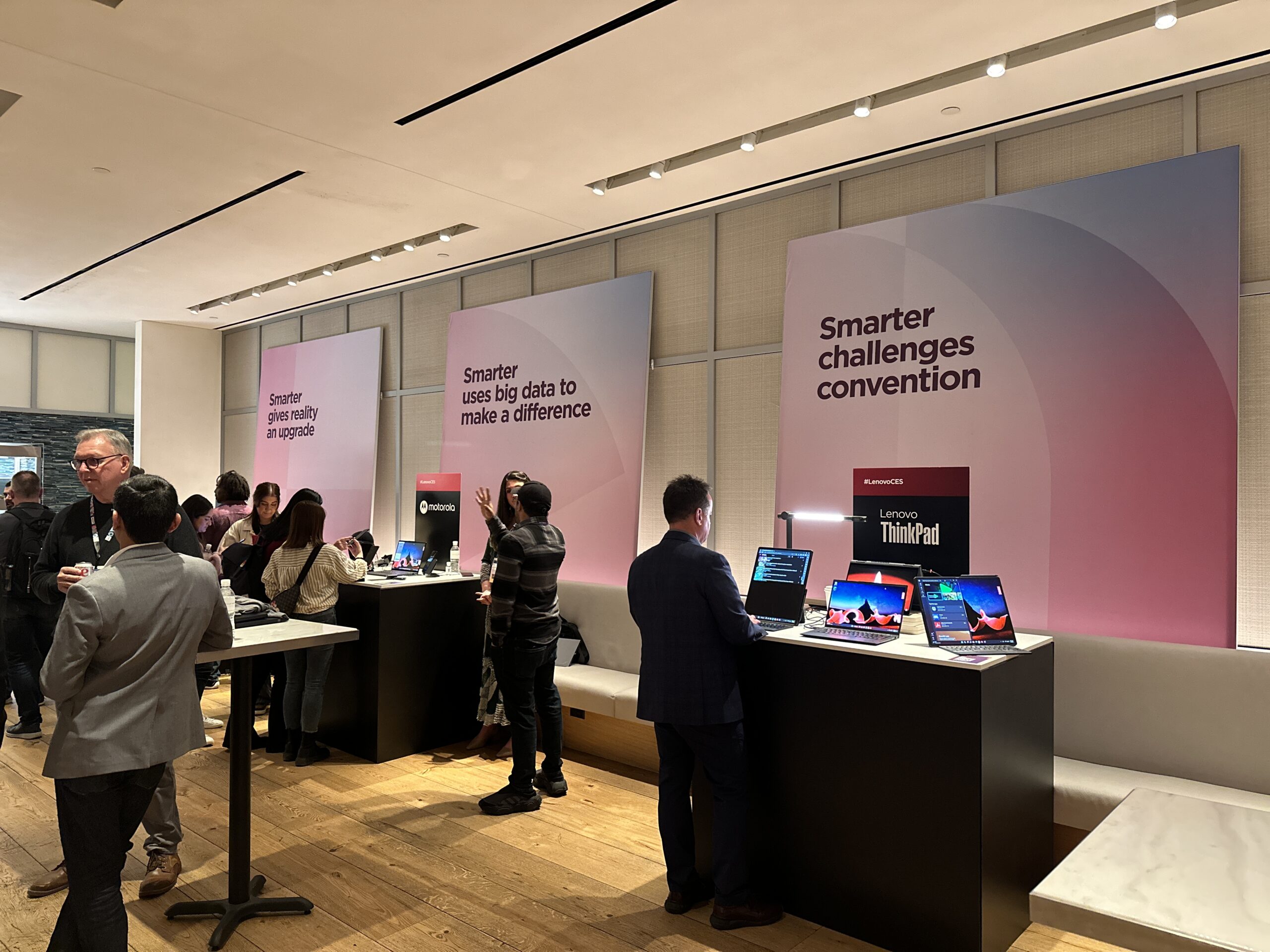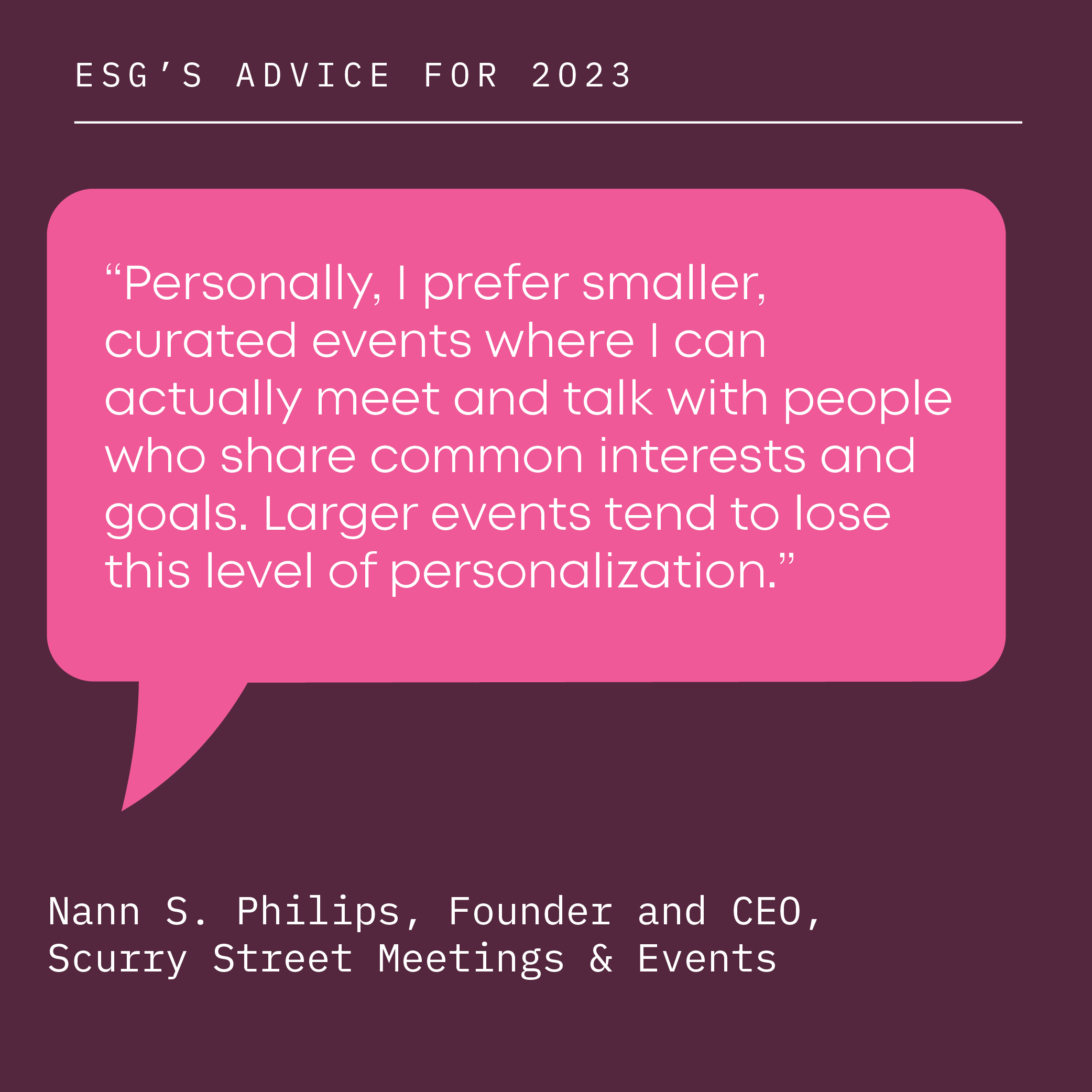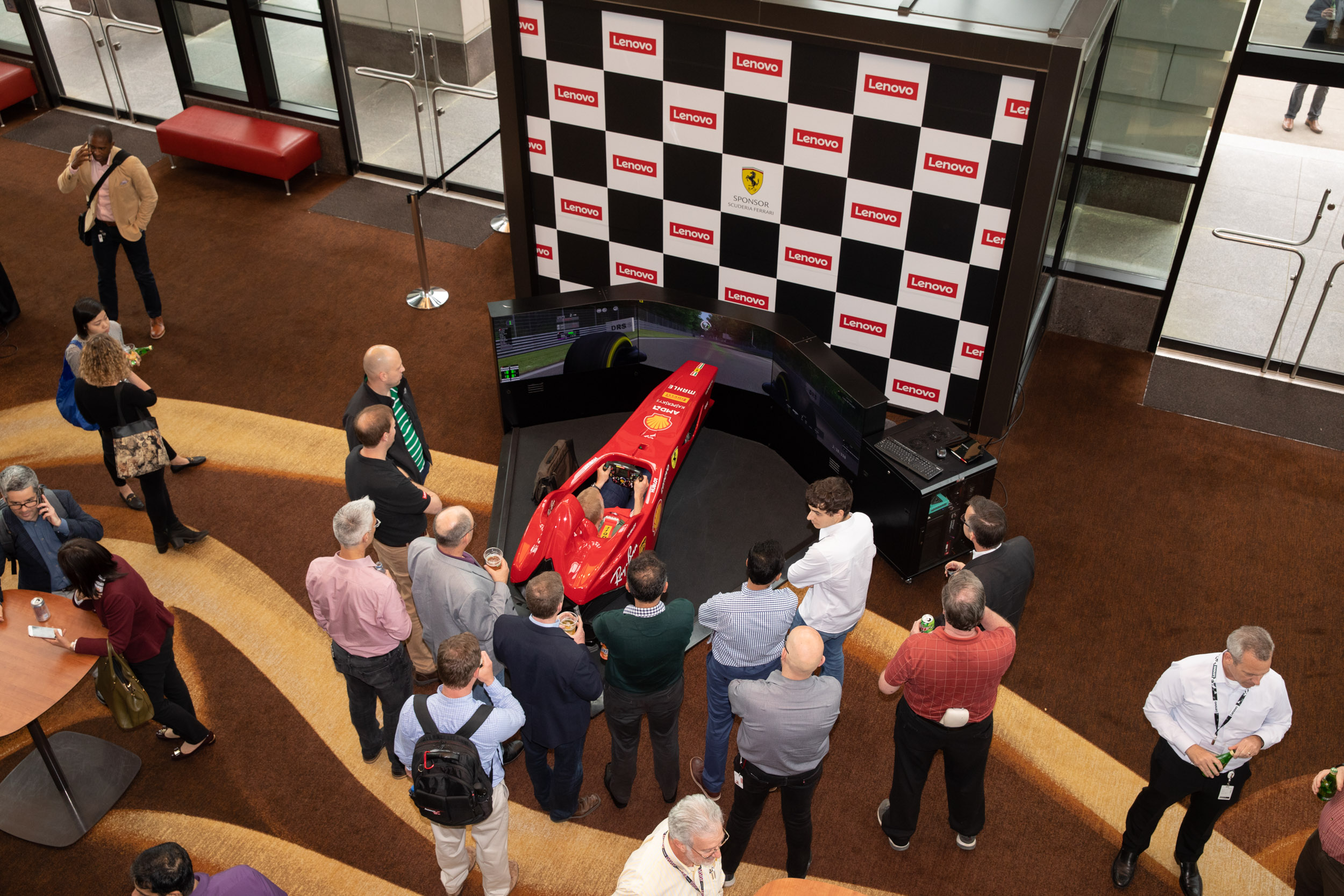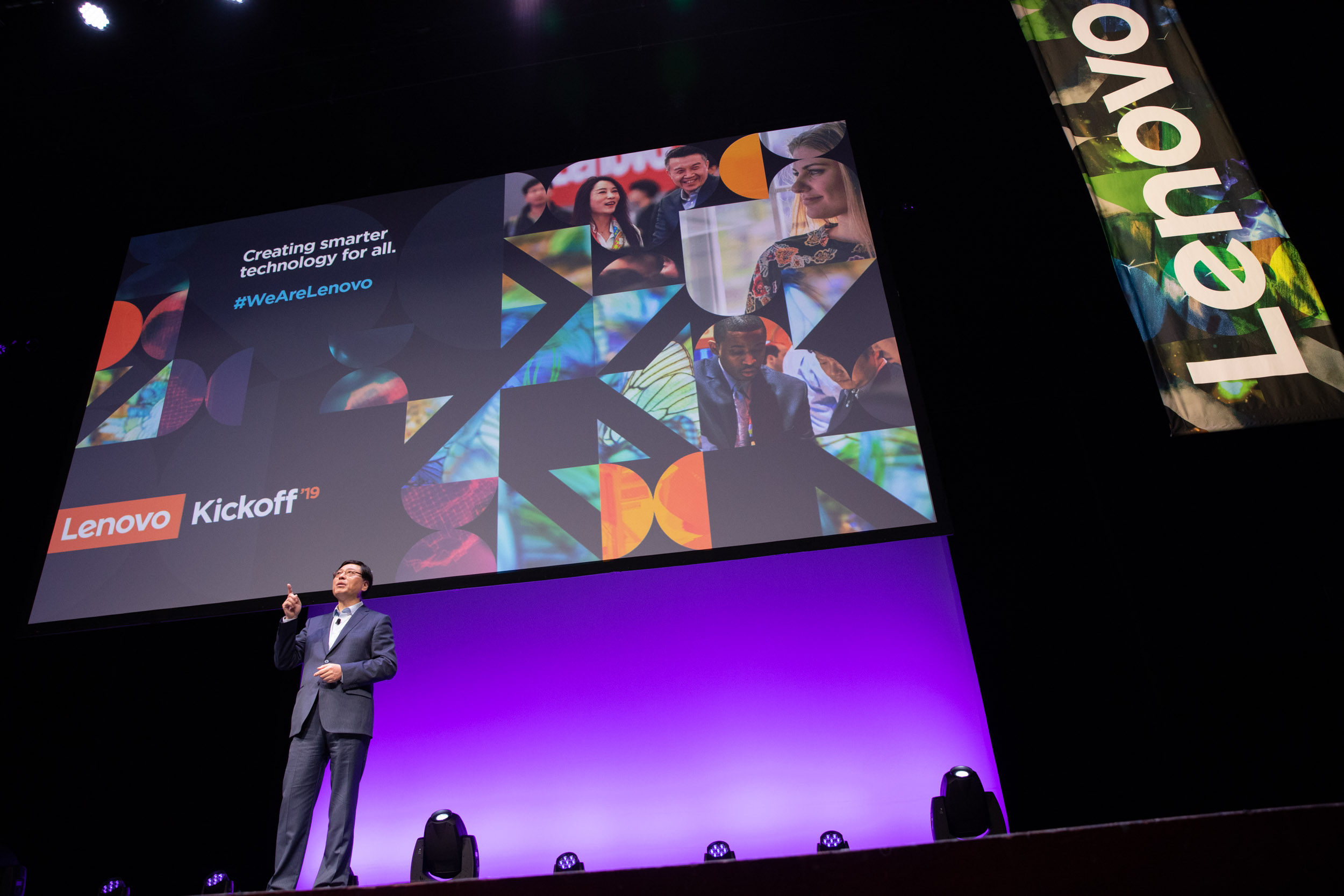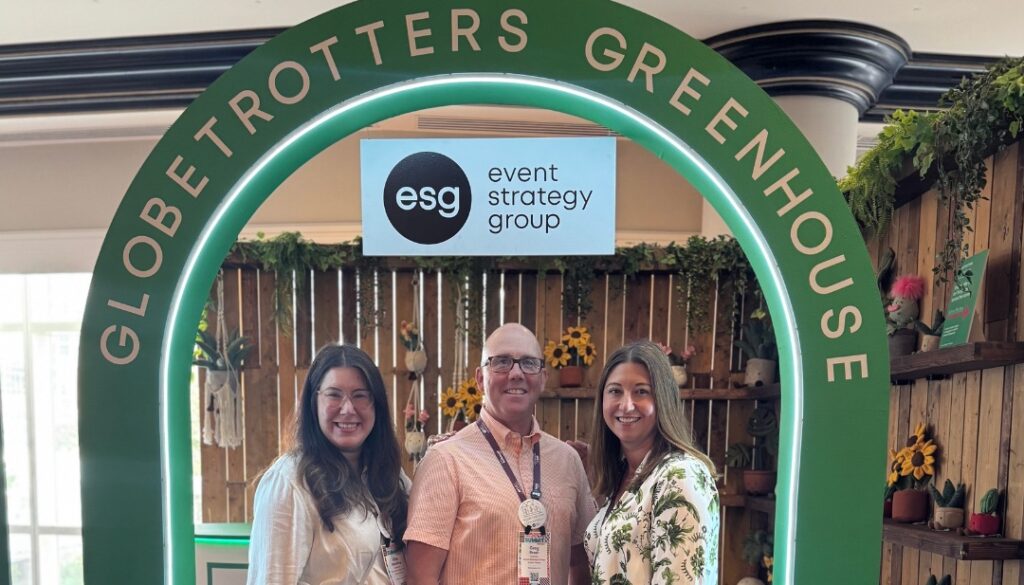
Event Strategy Group Combines Cuddly with Climate Action at CEMA Summit 2025

Philadelphia, Pennsylvania – September 09, 2025 – Event Strategy Group (ESG), a leading agency in B2B event marketing, was among the most highly sought-after activations at this year’s Corporate Event Marketing Association (CEMA) Summit. The agency’s innovative experience zone, “Globetrotters Greenhouse,” captivated attendees by combining whimsical, high-value giveaways with a serious commitment to sustainability.
Attendees—including industry partners and brand-side marketers—were invited into a charming, mock plant store environment designed specifically for busy event professionals. The activation’s central feature was an array of adorable Jellycat® plush plants, a playful nod to the challenges of keeping real plants alive while constantly on the road. Beyond the playful facade, the activation was built on a foundation of sustainability. The “Globetrotters Greenhouse” was
constructed with 90% repurposed and recycled materials by a local Austin company to minimize its carbon footprint. ESG also partnered with One Tribe, an ICROA-certified climate action platform, to calculate and offset the entire carbon footprint of the CEMA Summit. Attendees voted on three different carbon-offsetting projects—from biodiversity conservation in Indonesia to solar power in India—with the winning project, the Rimba Raya Biodiversity Reserve Project, receiving funding.
“ESG’s activation hit all the points to make it memorable and relevant – the eye-catching design was made for social moments, the gamification and Jellycat giveaways made it fun, and the philanthropy angle and usage of sustainable materials gave everyone who engaged a feel-good moment,” commented Jihan Donawa, Sr. Growth Marketing Manager, Swoogo.
The experience was thoughtfully curated, featuring custom-canned cocktails and hibiscus tea served by staff in logoed aprons, a custom Spotify playlist, and a photogenic “forever fresh” neon and greenery wall.
“This was one of my favorite activations at CEMA Summit,” said Meg Fasy, Founder & CEO, FazeFWD, former Board Member and 20-yr. member of CEMA. “ESG always brings a fresh, creative and fun experience to the conference.”
The activation highlighted ESG’s innovative approach to creating engaging and impactful brand experiences. The team received numerous thanks from attendees for their work and for the positive impact the activation had on the event.
“We wanted to bring the same fresh thinking and innovation we bring to every client engagement to our own activation” said Kellie Mayrides, CMP, Client Success Manager at ESG and lead on the project. “Globetrotters Greenhouse was truly a joy to bring together. CEMA Summit 2025 will be hard to top, but we already have our thinking caps on for next year’s conference!”
About Event Strategy Group
Since our founding two and a half decades ago, we’ve produced thousands of corporate events. Massive ones, small ones, and somewhere-in-between ones. Digital. In-person. Hybrid. Regardless of format, events need to move the needle. ESG helps brands accelerate sales cycles and deepen their customer relationships. Find out what getting “it” done for clients means and visit us at www.esg.us.
MEDIA INQUIRIES
Khaner Walker
khanerw@arcsenseconsulting.com
1-919-412-1566

Event Strategy Group Celebrates 25 Years of Transforming Corporate Events Into Unforgettable Experiences

Philadelphia, Pennsylvania – May 1, 2025 – Event Strategy Group (ESG), a leading event marketing agency specializing in B2B experiences, proudly announces its 25th anniversary today. Since its founding in 2000, the agency has delivered thousands of memorable events for global brands across the technology, finance, healthcare, and professional services sectors.
“The secret to our success and longevity over the past 25 years has been the talent, creativity, and hard work of every team member here at ESG,” said Renee Scullin, President & Co- Founder of ESG. “Because of their passion, we’ve continually had the growing privilege of working with a diverse range of clients, bringing their visions to life, and making unforgettable experiences.”
“At an event, ‘it’ changes nearly every minute and sometimes every second, but getting ‘it’ done is what we truly excel at,” said Co-Founder Norm Aamodt. “From fully 3D designing an event space, to building a stage, ensuring transportation is on time, and everything in between, this mantra has become our mindset, and I fully believe it’s why we’ve enjoyed the longevity we’ve had.”
Since first opening their doors, ESG has:
- Delivered more than 12,000 corporate events globally
- Worked with hundreds of companies, from start-ups to the Fortune 100
- Expanded sustainability practices across its portfolio
- Grown its team and capabilities, adding over 50 positions in creative, design, planning, event tech, and production
“Thank you to our amazing people, amazing clients, and an amazing community that has enabled us to grow and thrive,” continued Scullin. “It’s been the adventure of a lifetime, and I truly feel like we’re just getting started!”
About Event Strategy Group
Since our founding two and a half decades ago, we’ve produced thousands of corporate events. Massive ones, small ones, and somewhere-in-between ones. Digital. In-person. Hybrid. Regardless of format, events need to move the needle. ESG helps brands accelerate sales cycles and deepen their customer relationships. Find out what getting “it” done for clients means and visit us at www.esg.us.
MEDIA INQUIRIES
Khaner Walker
khanerw@arcsenseconsulting.com
+1-919-412-1566
Event Strategy Group Announces Multiple New Hires in Q1 2025

Philadelphia, Pennsylvania – Mar. 21, 2025 – Event Strategy Group (ESG), a leading event agency, today announced the strategic hiring of four new professionals to support its expanding client base and evolving project scopes. The additions bring diverse expertise and strengthen ESG’s capabilities across creative strategy, accounting, administration, and event technology.
“We are thrilled to welcome Kate, Melissa, Jade, Christina, Lia, and Sam to the ESG team,” said Renee Scullin, President & Co-Founder of ESG. “Their diverse backgrounds and proven track records will be invaluable as we continue to grow and deliver exceptional experiences for our clients.”
Kate Burton, Event Manager: Kate brings a wealth of working with Fortune 500 companies in effectively planning and executing brand campaigns. Prior to joining ESG, she spent seven years with Wasserman creating and delivering event and hospitality programs. She received her MS in sport and fitness administration from Florida State University and her master’s in business administration from the University of South Florida.
Sam Ferkler, Event Technology Coordinator: Sam recently graduated from West Chester University of Pennsylvania with a BS in Computer Science and a minor in statistics. In his new capacity, he will join the technology team and oversee systems integrations from event technologies into client systems, website and application development, and more.
Jade Graddy, Senior Creative Strategist: Jade brings a wealth of experience in writing, editorial, content creation, and creative strategy. A global citizen with professional experience on six continents, Jade is passionate about helping clients tell their stories effectively. She previously served as Senior CS Editorial Manager at Shorthand and Communications Consultant at Campbell & Company. Jade holds a BA in linguistics and a minor in human rights from the University of Washington.
Christina Knapper, Accounting Specialist: Christina brings nearly 24 years of experience in accounting across a wide variety of industries and experiences. She was most recently an Accounts Payable Specialist at Norris Furniture & Interiors and prior to then, was a Home Office Accountant at Liberty Property Trust for 20+ years.
Melissa Mulaney, Event Manager: Melissa brings a wide variety of event and marketing experiences to ESG having spent the past decade supporting client initiatives in house. She’s worked on corporate event and marketing teams for RR Donnelley, Vericast, Doosan, and SAB N. America. She graduated from Monmouth University with a BS in business administration with a concentration in marketing.
Lia Togila, Executive Admin: Lia has three years of experience in project coordination and brand strategy, with a focus on driving creative projects to success through innovative problem-solving and audience targeting. She previously worked as a photographer and production supervisor at Philip Gabriel Photography and as a photo editor at Bloomsburg University of Pennsylvania. Lia graduated from Commonwealth University-Bloomsburg with a degree in mass communication with a focus in photojournalism.
“These new hires will play critical roles in supporting ESG’s continued growth and ensuring the agency delivers innovative and impactful solutions for its clients,” continued Scullin. “We remain committed to investing in top talent and providing our clients with the highest level of service.”
####
About Event Strategy Group
Since our founding more than two decades ago, we’ve produced thousands of corporate events. Massive ones, small ones, and somewhere-in-between ones. Digital. In-person. Hybrid. Regardless of format, events need to move the needle. ESG helps brands accelerate sales cycles and deepen their customer relationships. Find out what getting “it” done for clients means and visit us at www.esg.us.
MEDIA INQUIRIES
Khaner Walker
khanerw@arcsenseconsulting.com
1-919-412-1566

Event Sponsorships & Maximizing ROI

Sponsorships are a crucial element of the event eco-system for organizers, sponsoring organizations and attendees, alike. When done well, sponsorship activations foster valuable interactions between attendees and your company.
So let’s discuss how you can maximize ROI with your precious event sponsorship dollars, drawing from insights shared by our experts here at Event Strategy Group.
- Don’t Wait to Discuss ROI: It’s essential to define and communicate goals for an event at the outset. Establish how you will measure success — whether through Net Promoter Score (NPS) at the booth, the number of leads gained, RSVPs, or actual attendance figures. Clear internal communication at the start ensures everyone is aligned on the objectives and that you’re measuring the KPI’s that actually matter post-show.
- Focus on the Attendee: Brands have a lot to say to attendees, but ROI means ensuring the right content finds the right people (and demonstrating this exchange happened). Effective sponsorships focus on what will pull attendees to engage with your activation, rather than how to push the sponsor’s sales pitch to them. Strategies such as personalization and gamification can create experiences that will draw attendees in and stick with them after the event.
- Leverage Event Technology: There are myriad options when choosing among event tech, but there are several types we keep coming back to:
- Personalization: Any event tech that enables personalization is one we’re all in on. A great example (and one we’ve pioneered) starts with insights gathered during event registration, that are then analyzed by AI, and both are then combined and used live onsite. Our clients are finding the results here to be a very powerful boost to their ROI.
- Micro Fencing: Digital fencing around targeted areas can notify attendees as they approach specific experiences, adding a layer of engagement and value for sponsors. Adding to this the personalization we mentioned above…you are now speaking our love language!
- Gamifying the Experience: Innovative uses of technology can extend even to your hotel key card! For one engagement, we put a QR code on attendees’ hotel key cards that provided them with daily event challenges and further integrated with personalized text messaging. This direct channel of communication deepened users’ experience with the event app and their curiosity with the brand and their offerings.
- Approach Pay-to-Play Cautiously: Sponsorship offerings should be specific and aligned with the event’s content objectives. Sponsored speaking opportunities can be powerful engagements and can also be disasters, if attendees feel like they are simply sitting through a sales pitch. Too many paid speaking opportunities (say one right after the other) can quickly lead to a disjointed attendee experience they quickly tune out of. Have a clear understanding of what the organization is offering and ensure your content aligns with what the audience is expecting.
Demonstrating and maximizing event ROI can be done – we do it nearly every day! Interested in exploring any facet of the above in more detail? Need a fresh look at at your sponsorships or want to explore how event tech can support them? Reach out to us at info@esg.us.


Event Agency Wraps 15th Consecutive Consumer Electronics (CES) Show

PHILADELPHIA, PENNSYLVANIA – Feb. 20, 2025 – Event Strategy Group (ESG), a leading event agency, has a long history in supporting Lenovo’s marketing efforts around the globe, and this year is celebrating a 15-year milestone of producing the Company’s CES show.
“We had this idea of taking over a space outside the convention center and turning it into an ‘invite-only,’ destination site for Lenovo’s customers and partners back in 2009,” said ESG co-founder Norm Aamodt. “The idea really worked, the client loved it, and together we have expanded on it nearly every year since. This year’s showcase was one of the largest CES shows we’ve ever produced, and I believe, our combined best yet.”
A lot has happened in the 15 years ESG has been at CES, especially as of late as in-person events continue to have a strong post COVID rebound. The 2025 show was one of the most impactful ones yet. Since starting to produce events at CES in 2010, ESG has seen:
- CES attendees grow by 17.5% from 120,000 attendees in 2010 to 141,000 in 2025
- The launch of connected TV’s, 3D printers, driverless cars, the first wearables, and voice assistants at the show
- Musical acts from Imagine Dragons, to Smash Mouth, Matchbox Twenty, and many more take the Lenovo stage at night
“While we’re renowned for our logistical excellence and boundary-pushing productions, at the core of our relationships is serving as a trusted, creative partner to our clients,” continued Aamodt. “15 years at CES with one client is an incredible testament to the exceptional work our team does and their dedication on behalf of the world’s best brands.”
About Event Strategy Group
Since our founding more than two decades ago, we’ve produced thousands of corporate events. Massive ones, small ones, and somewhere-in-between ones. Digital. In-person. Hybrid. Regardless of format, events need to move the needle. ESG helps brands accelerate sales cycles and deepen their customer relationships. Find out what getting “it” done for clients means and visit us at www.esg.us.
MEDIA INQUIRIES
Khaner Walker
khanerw@arcsenseconsulting.com
+1 (919) 412-1566
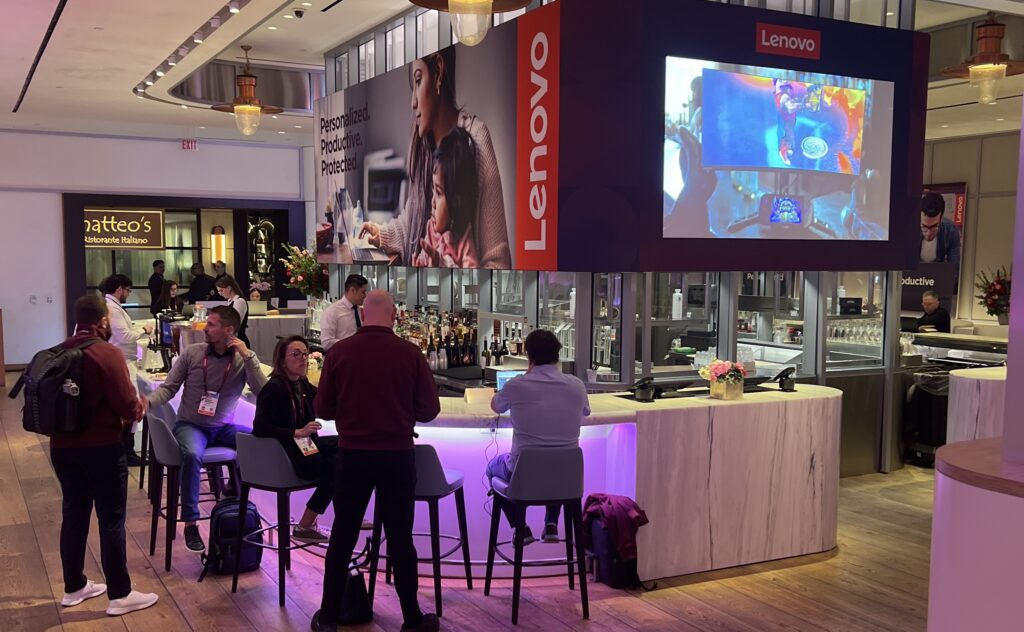
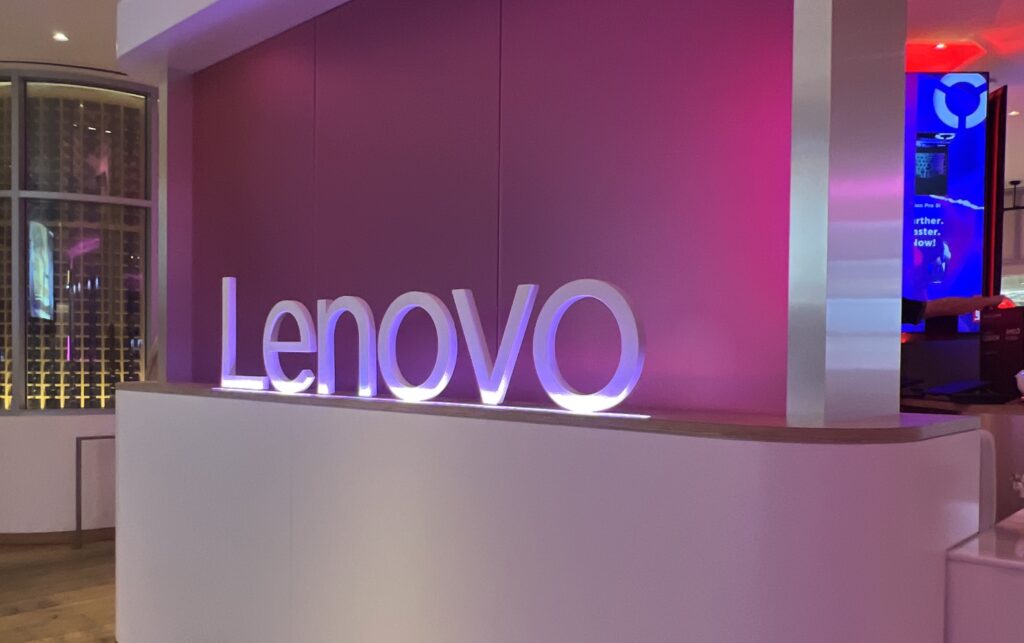

Event Apps and Emerging Event Tech

In today’s fast-paced event landscape, technology is revolutionizing how events are planned, executed, and experienced.
Event apps and emerging tech solutions are at the forefront, making lives easier for organizers and attendees alike. Here’s a closer look at why you should consider an event app and what new technologies are shaping the industry.
Why You Should Have an Event App
- Streamlined Event Management
- Centralized Information: An event app consolidates all essential details—speaker information, schedules, venue maps, and more—into one accessible location. This not only reduces the need for printed materials, it also minimizes attendee queries, as they can find everything at their fingertips.
- Data Collection and Analytics: Event apps facilitate data collection and provide valuable insights, allowing you to make informed decisions and enhance future events by having a clear understanding of overall satisfaction and engagement levels.
- Improved Attendee Engagement
- Real-Time Updates: Events often face last-minute changes. An event app makes it easier to communicate updates, ensuring attendees are always informed about time changes, new speakers, relocated sessions, and so much more.
- Personalized Experience: Attendees can create personalized schedules, receive reminders for those sessions, and highlight their profiles (like their LinkedIn) for networking purposes.
- Monetization and Sponsorship Opportunities
- Branding and Ads: Event apps offer numerous branding opportunities, such as splash screens, banner ads, and virtual event booths, providing added value to sponsors.
- In-App Purchases: Attendees can quickly purchase access to specific sessions or events, such as when a new speaker is announced, enhancing their experience.
- Sustainability
- Paperless Solutions: By reducing the need for printed materials, event apps contribute to sustainability efforts, making sponsors happy. Attendees can download presentation materials directly to their phones, promoting additional sharing and exposure.
- Digital Exhibits and Content: Event apps support digital exhibits, reducing the environmental impact of physical materials.
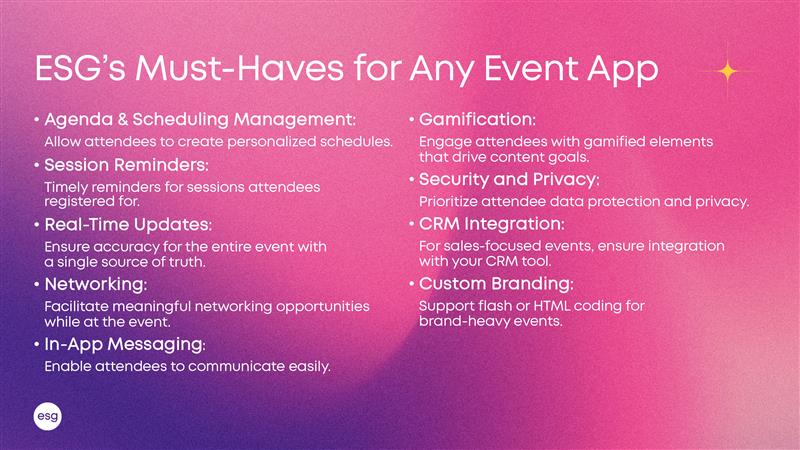
Choosing the Right Event App
Firstly, define the scale of your event and identify app features that are an absolute must (like schedule management, networking tools, venue mapping, etc.). Then focus on attendee experience – decide what type of content you primarily want them to see when they log in. Should it be content rich, brand heavy, or something else? Your goals here will greatly inform the solution you choose.
ESG’s Must-Haves for Any Event App
- Agenda and Scheduling Management: Allow attendees to create personalized schedules.
- Session Reminders: Timely reminders for sessions attendees registered for.
- Real-Time Updates: Ensure accuracy for the entire event with a single source of truth.
- Networking: Facilitate meaningful networking opportunities while at the event.
- In-App Messaging: Enable attendees to communicate easily.
- Gamification: Engage attendees with gamified elements that drive content goals.
- Security and Privacy: Prioritize attendee data protection and privacy.
- CRM Integration: For sales-focused events, ensure integration with your CRM tool.
- Custom Branding: Support flash or HTML coding for brand-heavy events.
While high-budget apps offer numerous features, ensure you only pay for what you need to maximize ROI. It’s about getting the right features bells, than getting all of the bells and all of the whistles. A frequent example is ensuring an app’s existing platform can plug into your company’s CRM – finding exact questions like these and ensuring requisite replies will ensure you’re choosing the one that’s right for you.
Finally, ensure its accessibility and security meets today’s standards. Choose an app that complies with accessibility standards like WCAG and security / privacy standards like GDPR. Attendees and the companies they work for want to ensure both of these boxes are checked.
Adopting the right event app and leveraging emerging technologies can significantly enhance event management and attendee engagement. By carefully selecting features that align with your event’s goals, you can create a seamless and impactful experience for all participants.
Interested in learning more? Watch the entire replay below or send us a specific question about your event, and someone on our team will respond as soon as possible!

Registration: More than Data Collection

Registration is the cornerstone of any successful event, but its utility extends far beyond merely signing up attendees. Our event techs at ESG breakdown how you can leverage registration tools throughout your event lifecycle to maximize engagement, streamline processes, and enhance the overall experience.
Expanding the Utility of Registration Tools
- Starting Simply: Effective registration begins with a streamlined registration experience. Participants hate navigating through lengthy forms, so keeping it simple is key. Utilizing magic links can eliminate the hassle of passwords, making it easier for attendees to register. Additionally, ensure that every aspect of your registration site is tested thoroughly for broken links and bugs to avoid any technical hiccups.
- Combining Registration and Event Portals: Creating a unified portal for registration and sponsors can provide significant value. Not only are there cost savings from merging two sites into one, but it also boosts engagement. Sponsors can select their booths, choose sponsorship levels, and upload their branding directly through the same portal. This integration also simplifies your back end data access and ultimately enables advanced reporting, providing real-time insights into registration numbers, payment statuses, cart abandonment, and so much more.
- Extending Throughout the Event Experience: Savvy event agencies and companies are utilizing registration data beyond the initial sign-up, and to great affect in greatly enhancing attendee engagement. Pairing the personalized data gained from registration with an event app and technologies like QR codes, RFID, and Bluetooth can create amazingly seamless engagements for any event. Personalized agendas, location-based recommendations, and real-time messaging based on an attendee’s preferences will automatically turn up the onsite event engagement experience for any brand, and furthered even more by using AI…
- Leveraging AI in the Registration Process: Companies are increasingly using AI to personalize attendee experiences. The data from a short questionnaire (4-5 questions max) that’s tied to client goals can then be used to segment our audiences live at an event. The same event tech then immediately lets our client know who’s walking up to them, helps them tailor their talking points, and customize their pitch. AI can also present tailor-made wayfinding suggestions for attendees while they’re at the event booth. The opportunities here are endless, but when done correctly, begin at the registration process!
Encouraging Attendee Registration
To boost registration rates and minimize drop-offs, consider strategies like:
- Chasing Abandoned Registrations: Use reports to identify and follow up on incomplete registrations.
- Incentives: Offer early bird pricing or enter registrants into a raffle to encourage sign-ups.
- Drip Campaigns: Gradually release information about the event, such as keynote speakers and special sessions, to maintain interest and drive registrations during lull periods.
The registration process is much more than a gateway to your event—it’s a powerful tool that can drive engagement, streamline operations, and enhance the overall attendee experience. By integrating advanced technologies and leveraging AI, you can transform your event into a seamless and memorable experience for all participants.


Virtual Events that Deliver Value: A Tech Trek Recap

The pandemic accelerated the evolution of event technology, pushing companies like ours to quickly adapt, scale, and invest in this booming sector. As we navigated our collective way out of COVID-19, the pendulum swung almost fully back in the opposite direction as attendees were motivated to return to in-person, physical events.
Today, we are finding a true equilibrium – one that incorporates both virtual events and physical ones into our clients’ ongoing event strategy. Virtual events will continue playing a role for brands connecting with audiences, as they offer several advantages:
- Extended Reach: There’s no geographical barrier, allowing broader audience participation from anywhere.
- Content Maximization: Content created for virtual events can be repurposed across social media and other channels – and done so with more ease and speed than in-person.
- Cost Savings: Virtual events are frequently more cost-effective than in-person gatherings.
- Sustainability: Virtual events contribute to sustainability goals by reducing carbon footprint, a growing concern to our industry and our clients’ environmental, social, and governance goals.
- Metrics and Analytics: Virtual platforms provide robust data capture, offering valuable insights into attendee engagement and behavior.
For complex virtual events, the planning process mirrors that of in-person events. Meanwhile, simpler events (like webinars) can be organized swiftly without extensive preparation. At Event Strategy Group, we work with clients to find the right combination of technology and format that aligns with their budgets and objectives.
Audience Expectations and Engagement
Capturing and retaining attention is a universal challenge and audiences expect unique and engaging experiences, whether they’re attending in person or virtually. For digital events, incorporating interactive elements like having a DJ, a wellness activity, or a culinary experience can enhance event attendee engagement and deliver the exact experience a brand is looking for in an effective manner.
Debunking Zoom Fatigue
The concept of “Zoom fatigue” has been widely discussed, but it’s important to recognize that the challenge of engaging presentations and effective speaker coaching exists in both virtual and in-person events. The key is to curate content for the medium to ensure speakers are well-prepared, regardless of the format.
Broadcasting Technologies
Partnering with a company like ESG allows us to select and deploy the right technology for the exact type of attendee experience needed, and integrating it seamlessly within your company’s systems and branding. Our goal is to simplify the technical aspects so you can concentrate on content and communication, mirroring the value proposition of in-person events.
Virtual events are a tactic that continue delivering value and should be strategically incorporated along with an in-person event strategy. Understanding when to deploy each format and embracing virtual as a permanent part of your toolkit going forward will ensure your brand’s event strategy is more impactful and engaging than ever.
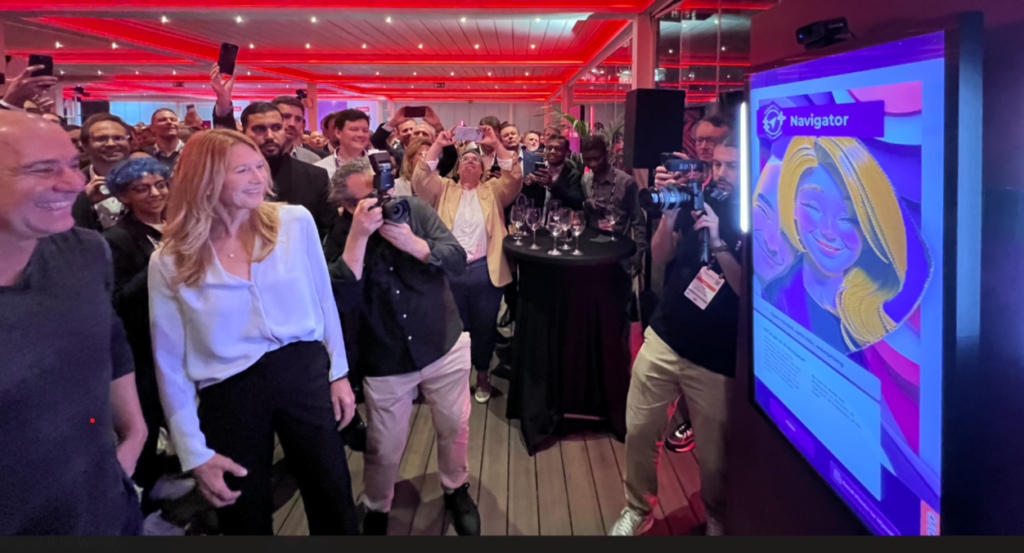
ESG and Fivestone Studios Intelligently Accelerate AI Journeys for Lenovo’s VIP Customers

Attendees at Lenovo’s annual innovation showcase, Tech World ‘24, experienced artificial intelligence (AI) in a way few others have been able to thanks to Event Strategy Group (ESG), a leading event agency, and Fivestone Studio’s custom creation of the AI Journey Accelerator. The immersive experience reflects Tech World’s remarkable history of innovation and transformation, and fully demonstrates this year’s theme, “Smarter AI for All.”
With Lenovo’s technology and hardware solutions leading the show, the ESG and Fivestone teams sought to develop a curated experience that matched the event’s main attractions. Enter one of Tech World’s most exciting innovations: the Lenovo Solutions and Services Group’s AI Journey Accelerator, a definitive next-generation digital photo booth experience powered by generative AI.
“We hear about AI all the time, but we don’t necessarily get to interact with it,” said Sarah Babb, Creative Director at ESG. “We wanted to tailor-make an experience that embraces AI to showcase Lenovo technology while telling Lenovo’s full Smarter AI for All story — from solutions and services to infrastructure and devices. We also just wanted our attendees to have some fun! The AI Journey Accelerator is a proprietary solution that checks all three boxes: it combines a set of interactive questions with a Stable Diffusion image generation model to determine where participants are in their current AI adoption process, provides personalized insights and resources, and a one-of-a-kind generative AI portrait—all run locally on Lenovo hardware.”
“This project marks Fivestone’s foray into customer-facing, AI-powered experiences, setting a new standard for interactive technology engagement,” said Fivestone Studios Partner and Executive Creative Director Traylor Woodall. “Most studios are now leveraging AI for ideation and efficiency behind the scenes, but we brought it front-and-center by crafting an immersive branded experience that showcases Lenovo’s processing power while also redefining what a photobooth can be in the digital age. By merging creative AI with user-friendly design, we’ve expanded the creative potential for participants, giving them a tangible, memorable keepsake that blends art, technology, and strategic interaction in groundbreaking ways.”
With more than half of Tech World ’24 attendees engaging with the tool, the AI Journey Accelerator is becoming a permanent feature of Lenovo’s trade show presence moving forward.
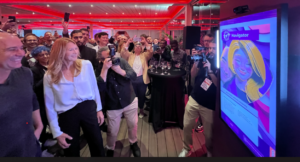
Creating the AI Journey Accelerator
To demonstrate Lenovo’s AI processing power in each engagement, the teams had the privilege of harnessing the brand’s industry-leading hardware, running the experience on a Lenovo ThinkStation P8 Workstation. For everyone involved, this ensured seamless local performance in photo capture, AI processing, and image generation.
The team worked with Lenovo to identify five key personas representing unique stages in customers’ AI adoption journeys. For these Investigator, Navigator, Catalyst, Coach, and Achiever personas, designers crafted custom logos and themes aligned with Lenovo’s brand guidelines. Fivestone also offered style options showcasing AI’s creative flexibility, from painterly brushstrokes to futuristic, three-dimensional interpretations.
Understandably, the team’s process for addressing this unique challenge involved exhaustive use of the latest developments in generative AI. For the customized AI photos delivered through the AI Journey Accelerator, Fivestone’s team first ran extensive tests using existing generative AI image systems, as well as custom-built options, to optimize workflows. “The magical part of an AI photobooth is how it interprets the source image by reimagining composition, lighting, and style,” said Justin Eslinger, Director of Creative Technology for Fivestone Studios. “Especially when the expectation is a perfectly branded image on the first try, every time, the main challenges are in consistency and control. Getting everything right requires a lot of testing with a variety of people and environments … and an artistic eye and hand to help sculpt the final result.”
Next, to develop the front-end kiosk application, the team streamlined the development pipeline by using the Unity Game Engine. With its Node.js backend, the finished application manages AI generation requests via Stable Diffusion, marketing email capture, image storage, and customer email delivery.
About Event Strategy Group
Since ESG’s founding more than two decades ago, we’ve produced thousands of corporate events. Massive ones, small ones, and somewhere-in-between ones. Digital. In-person. Hybrid. Regardless of format, events need to move the needle. ESG helps brands accelerate sales cycles and deepen their customer relationships. Find out what getting “it” done for clients means and visit us at www.esg.us.
About Fivestone Studios
Fivestone is an immersive multimedia studio that leverages design, technology and storytelling to create wonder and drive human connection. Drawing strength from five shared cultural touchstones – Honor, Bravery, Vision, Generosity, and Excellence – our groundbreaking multidisciplinary talents passionately resolve giant-sized storytelling challenges using emerging technologies and patent processes. Learn more at https://fivestonestudios.com: What can we help you create?

After 24 Years of Partnership, Agency Co-Founders Prepare for New Chapter

Agency Boasts 10,000+ Events Produced for Companies Like Lenovo, AMD, and More
Event Strategy Group (ESG), a leading event agency, today announced that Renee Scullin has been named President and Owner effective immediately. Scullin replaces Norm Aamodt, who will continue as an active member of the Company as Co-Founder until transitioning into a future advisory role. Scullin and Aamodt co-founded ESG together more than 24 years ago, and since then have grown the Company into one of the most innovative and widely known event and production agencies with clients all over the world.
Aamodt and Scullin first worked together as event managers during their tenure at SAP America. It was there they discovered their shared passions for bringing ideas to life and tackling new types of challenges.
“It has been and continues to be the journey of a lifetime since we started ESG more than 24 years ago,” said Scullin. “We started with a goal of producing one event per month in April 2000, and today we produce more than 800 events annually and employ a team of 40+ employees all over the world. At the heart of our success has been turning ideas into moments that captivate audiences, owning the countless logistics that go into every single engagement, and serving as a trusted creative partner for clients huge and small.”
Scullin played a pivotal role in keeping the Company going throughout several adversities and growing it during the pandemic while the rest of the event industry ground to a halt. She led their renewed investment into virtual and hybrid offerings to meet the evolving business climate and as a result, significantly increased the number of ESG’s new customers.
ESG will continue this path of continued growth from its Philadelphia-based headquarters and with this transition, will become a Woman-Owned Business pending future certification.
“We are committed to growing our employees’ careers – 90% of whom are women – and our presence in the communities they’re located in,” continued Scullin. “We celebrate being a woman-owned business that’s run by women daily, and the pride each of our employees takes in this next chapter of our journey. I cannot wait for what the next 24 years have in store for ESG!”
About Event Strategy Group
Since our founding more than two decades ago, we’ve produced thousands of corporate events. Massive ones, small ones, and somewhere-in-between ones. Digital. In-person. Hybrid. Regardless of format, events need to move the needle. ESG helps brands accelerate sales cycles and deepen their customer relationships. Find out what getting “it” done for clients means and visit us at www.esg.us.

4 Things Keeping Event Profs Up at Night…Other than AI

As the year winds down, we brace ourselves for the inevitable deluge of “Trends for 2024 in the ______ Industry” articles. While I suppose you could put this post into that category, I prefer to call it “Four Things Keeping Event Profs Up At Night…Other Than AI”
I spend most of my time speaking and meeting with event marketers and these topics come up again and again.
Content/Format
There is a genuine interest in re-thinking what is being communicated and how it is delivered. Brands understand that audience demands have changed, and we’re excited to see a willingness to take risks. Attendees are even accepting of some missteps if they are made in an effort to deliver compelling content in an engaging (often shorter) format. Leaning on “what we did last year” is a dangerous strategy. Looking ahead, we’ll be tasked with finding the optimal way to deliver content to our audience from event to event and session to session.
Data
Anecdotes from the sales organization just don’t cut it today. Events make up a higher percentage of marketing budgets than ever before and with that comes increased scrutiny. Management expectations are direct: either demonstrate value or that event spend will be allocated elsewhere. Consider this a shift from ‘nice to have’ to ‘must have’.
One of my colleagues often asks a great question as we kick-off event planning – what needs to change in the attendee from pre-event to post-event? And if we’re going to move that needle, what metrics are we going to use?
Access to the right data is critical to establishing a credible link between budget and return. If you don’t have a plan for data capture, analysis and delivery for every engagement, cue the insomnia.
Sustainability
Corporate governance is pushing sustainability initiatives, and events are an easy target. Up to this point, we’ve seen a lot of lip service paid to sustainability in our industry, only to be quietly walked back if those measures negatively impact the budget.
Increasingly though, we’re seeing decisions made up and down the supply chain with sustainability as a meaningful criterion. Recently a global marketing leader at a tech firm confided improvements in sustainability standards are part of her performance metrics. If this isn’t yet on your priority list, it’s coming.
Community
Once upon a time, an event was a singular engagement where the brand told the audience what it wanted them to know. Today, an event is just one touchpoint in the ongoing conversation between a brand and its customers (or prospective customers). It’s also where attendees connect and engage with each other.
Survey after survey, we consistently hear that peer-to-peer networking is a primary driver for event participation. And like it or not, people are going to talk about your brand and your products. In the absence of a curated community, there are plenty of forums to fill the void, but probably not in the way you would prefer. Event agendas with ample space for networking and sessions that facilitate meaningful connections within your audience have become essential.
Events are now widely considered one of, if not the, most powerful marketing tools in a company’s arsenal. The key to success in 2024 and beyond will be a willingness to evolve our strategies and a relentless drive to provide the utmost value to our attendees.
This article originally appeared on the Meeting Professionals International Philadelphia Area Chapter blog in December 2023.

Ah-Ha Moments from CEMA Summit 2023

I’m Kellie Mayrides, Client Success Manager for Event Strategy Group. I’ve worked in the events industry for 20 years and joined the ESG in summer 2022. My role includes a little bit of everything – proposal creation, new client onboarding, event management, and marketing.
I was recently a first-time attendee at CEMA Summit, the premier gathering of corporate event marketers in the country. Here’s a round up of my top takeaways:
Demystifying Data
Data can be intimidating for those of us who don’t consider ourselves “numbers” people and it’s easy to think of data collection and analysis as the domain of the most tech savvy among us. But three of the sessions I attended made it feel infinitely more accessible.
The Data Hero’s Journey, run by ITA Group, presented a framework for identifying the right data to meet event goals at various points during the event lifecycle. From budgeting to content creation to post-event analysis, we asked:
What questions do we need to answer?
Example: How do we make sure the content at our event is relevant and useful to attendees?
What kind of data can help us answer those questions?
Examples: Hot topics in the industry, challenges attendees are facing, new technologies affecting the industry
How can we source this data?
Examples: Conduct a survey of past and potential attendees and sponsors, use AI to aggregate and analyze recurring topics in industry publications, Competitive conference agendas
How can we use the data to support decision making?
Examples: To create tracks or themes across sessions, to evaluate and select possible speakers
By breaking the process into bite-size pieces and allowing us to brainstorm within a small group, the process of data collection and analysis suddenly felt more accessible and, dare I say it…fun?
The exercise also got us to think beyond post-event survey data, which let’s be honest, is often where our data journey starts and ends. Our minds were opened to all the moments before and during an event when data can be illuminating.
At their session, Success by the Book: How to Develop KPI’s with Metrics That Matter, Jon Wolff of Lenovo and Joe Federbush of Evolio used Lenovo’s booth at the National Retail Federation Big Show as a case study and shared these best practices:
Weight your KPIs. Ranking your KPI’s in order of importance can not only assist in pre-show budget decisions, but it can also help you distill post event metrics into a clear and concise summary for internal stakeholders.
Use a mystery shopper to evaluate booth staff at competitor booths and your own using the same set of questions for a true apples-to-apples comparison.
Leverage AI to help you analyze raw data from your event. Nearly everyone is new to AI, so we shouldn’t be afraid to experiment – you may end up with new and unexpected insights.
And finally, in a session called Six Truths for Innovative Event Strategies run by StoryCraft Labs, we learned that people are willing to share emotional data if they feel it will be used responsibly. One exercise used emojis to track how we felt during different points of the event. I love this as an alternative to your typical survey question and because it’s such as easy ask of your attendees that you could track changes from pre-event to post event and in between.
Redefining Creativity
Another big takeaway came from keynote speaker Natalie Nixon, who underscored creativity’s evolving significance in generating business ROI. Nixon urged us to:
- Seek out what she called “creative abrasion” by bringing diverse sets of stakeholders together for ideation and feedback on possible ideas and solutions.
- Embrace improvisation and experimentation within your organization. When people are part of the improvement process, they are more likely to buy in to testing new concepts.
- Explore beyond the familiar to spark fresh ideas. For example, send your team to a conference outside your industry to gain new perspective.
Moreover, she emphasized that creativity is a skill set that you can grow with practice and workers that are able to leverage that skill will provide the most value to their organizations in an era of increasing automation and AI. As event marketers, we sit squarely in this nexus of creativity and ROI, and I like the idea that one begets the other.
Optimizing Session Length
Everyone who came to CEMA Summit is used to sitting on the event organizer side of a conference. My final takeaway was borne out of the opportunity to simply be an attendee.
Every session I attended included relevant content and most of the speakers were dynamic and engaging, but I felt a little bit like Goldilocks. The sessions where someone was talking at us often felt a bit too long, while the more hands-on workshop-style sessions that allowed us to talk with our fellow attendees never felt long enough.
It got me thinking…how we can get session length just right?
There’s been a lot of chatter in the industry about reducing the number of traditional keynote and panel sessions in conference agendas. After all, one-way communication can easily be replicated in a webinar. And while I’m not suggesting we eliminate these formats altogether, I would argue that these sessions needed to be shorter and punchier. An ideal length might be 20-30 minutes instead of 45-60.
I had a conversation with Nick Borelli, who led a session on The Power of Generative AI in Event Marketing, and he told me he identifies just one main goal for any talk he gives. For that session, it was simply to make people less afraid of and more willing to use AI to augment their human intelligence and hard work.
In contrast, if you’re going to give people a chance to think through solutions to real problems they face and collaborate with fellow attendees, err on the side of giving more time. The Data Hero’s Journey, for example, was an hour, but if it had been more like 90 minutes, I think we all would have been grateful for more time to work through the exercises.
Similarly, the hands-on aspect of Six Truths of Innovative Event Design was great, but between the cacophony of 3 facilitators trying to talk to us at different stations and 2 different exercises to experience at each one, it felt rushed. This was a shame, because I think there was a lot of rich learning to be had in that room. I almost felt like that session could have been broken into 3-6 shorter sessions spaced apart.
Keynote speaker Julie Williamson paused her remarks one point and invited us to talk with the person next to us about a time when we had to adjust our plan to execute our strategy. She had a hard time getting us all to quiet down so she could continue with her talk, which I think is further proof that we wanted to spend more time talking to one another.
The Power of Community
Lest that last bit read as a criticism of the conference, I can assure you it is not. In fact, if the problem is too much great content, it’s not a bad one for CEMA to have on its hands.
The conference was full of thought-provoking ideas and concepts and I left feeling lucky to be a member of this incredible community. Our collective knowledge and experience are unbelievably powerful and act as a multiplier when we share it with one another.

From Dubai to Frankfurt: Insights from GDP Connection and IMEX
Hi, I’m Kim Ringhoffer! I’ve been with Event Strategy Group for 5 years and I’ve worked on programs as varied as a Harry Potter World Experience in Orlando, Florida to a President’s Club in Bali, Indonesia. My passion is creating high-end VIP experiences across the world.
I recently had the opportunity to attend Global DMC Partners’ Connection in Dubai and IMEX in Frankfurt, Germany and here are a few of my top takeaways!
Family Matters
The line between work and family time is blurring more than ever. Allowing plus ones and even children on business trips is increasing motivation to attend programs.
One idea I found notable was separate adult-only and family-friendly incentive programs, where qualifiers would choose the option that suits them best. For programs that do allow children, touches like branded kids menus and kid-friendly activities or entertainment areas at evening events were encouraged.
This all aligns with the bleisure travel trend we’re seeing across the industry. According to a survey done by IHG Hotels in 2022, 60% of US respondents planned to add leisure days to a business trip in the next 12 months and 54% of business travelers said bleisure supports their work-life balance in a BCD Traveler Wellbeing survey.
Sustainability Takes Center Stage
Sustainability was a hot topic at both conferences. The central question: what does sustainability really mean and how can we accomplish it? In Dubai, a guest speaker from Purpose Net Zero talked about how to reduce event emissions, specifically, and offered their site as a place event professionals can use as a resource for strategies and information.
My favorite 1:1 appointment at Global DMC Partners Connection was with the DMC of the Nordics. They were not only some of the nicest people I met at the show, but I was blown away by their event options and their focus on sustainability and fully green venues. It’s now my mission to plan an event there!
The Power of Small Moments
One session that really hit home for me talked about how people are looking for something that will ultimately change them in some sense. Statistics were cited that programs that were able to accomplish this in some way, were the highest rated among attendees.
Whether it’s facilitating meaningful conversation among our attendees or offering an opportunity to give back through a charitable activation, finding ways for attendees to make a difference in their lives, or the lives of others, is something I’d like to intentionally build into future events.

Go Medium or Go Home: Brands Leaning Towards More Targeted Events

We recently created a beautiful CES activation for our friends at Lenovo. The world’s largest consumer tech show, a longtime January tradition, returned to Las Vegas on a grander scale this year. To me, though, it was cause for both comfort and pause. Some people — many of them with skin in the game — will tell you that the events industry is back to normal. I am not one of them.
This year’s CES attendance was a big rebound from 2022 but it still came in below the numbers from way back in 2010, let alone its pre-pandemic peak in 2019. The CES new tech announcements were fantastic as always (check out the Lenovo YogaBook 9i if you haven’t already) but there weren’t as many people there to gasp when the veil came off each product.
After a busy 2022 spent all over the US and abroad, my ESG team estimates that in-person
attendance at live events continues to lag somewhere between 65% and 80% behind pre-pandemic levels. The reasons are well-documented. Some attendees are hesitant to travel. Costs to businesses are up. Hotel, venue and food/beverage contracts are less flexible while attendee/sponsor registration is happening much closer to event dates. Incredibly, sponsorships costs have not budged, leaving brands with the prospects of paying the same or more for quite a bit less. I think some in the events industry take it for granted that brands will continue to bear this burden. Again, I’m not so sure.
A Time for Scrutiny
The beginning of the year is inevitably a time for taking stock. Companies are tweaking strategies, setting goals and, in many cases, tightening belts. This is the moment to dig deeper on what’s happening and scrutinize your own event portfolio/spending in light of it. This is precisely the right moment to ask:
- What are your company’s goals for this year?
- Do these goals acknowledge evolving realities or are they stuck in a pre-pandemic mindset?
- What events are you slated to host or attend and what is their scale?
- Are these events likely to have a measurable impact on your key objectives?
- Given new realities, are these events designed to provide maximum value to attendees?
That last question is key
Those in the business of organizing or attending big events are right to wonder how people are feeling and where the “normal meter” is set right now. It’s quite clear that people have undertaken a radical post-pandemic re-examination not only of their work but of their lives. Do they still crave the adrenaline rush of the mega-event or are they more comfortable with something more scaled down? Can they get what they need without attending at all? Your company darn well better be listening to what your audience is saying and designing an event portfolio that matches those needs. I took the temperature on my LinkedIn page and heard some thoughtful things back from a few of my connections.
A New Model
Sure, it’s a small sample size but those quotes are in line with everything else I’ve been hearing. My sense is that, for many, mega-events have outlived their usefulness. People are speaking volumes by not returning and the only companies that are seeing the same ROI are the ones that have markedly reworked their content strategy. The majority of attendees want something different, something special. I think people are willing to engage when they see something that matters to them. They are filtering out the noise and focusing on what matters.
The draw for smaller events? They tend to be better for relationship-building and they foster a sense of belonging. No one likes selling—they need collective problem-solving. Large industry events are still important to Lenovo, says Jon Wolff, Events Manager for the company’s Solutions & Services Group, but brands must adapt to the current climate. “Many attendees are becoming more selective about which events they attend in person. We are focusing in part on smaller, more targeted events. For example, we created something called the Lenovo Lounge. It’s a VIP event series, a more intimate experience with roughly 40-50 key individuals. These are invite-only conversations that focus on timely, specific topics and provide a valuable opportunity for networking.”
For those of you whose brands might be mulling issues like these, I offer five pieces of advice:
1. Talk to your audience and see what they want. Tailor your event strategy accordingly. Make it easy for people to engage — they’ve been through a lot. Choose venues closer to where people live and keep the events short. Ensure that the content on the agenda is absolutely best served in person.
2. Quality, not quantity. Focus on getting the right people — not the most people — into the room and then be sure to meet their most pressing needs.
3. Build community. See what you can do in between events to keep people engaged. Consider customer-led calls on a monthly or quarterly basis.
4. Adopt a more risk-averse event strategy. We’re calling it “Go medium or go home!” Several of our clients have openly discussed doing this as of late and there’s some wisdom in taking this approach.
5. Shift to hosted events. One of our clients was disappointed with the results of a sponsored, third-party event in 2022 so they are taking over the show, creating a customer conference for a legacy product and a potential road-show format for a new market they’re looking to break into.
We at ESG are not show organizers — we’re builders, creators who are constantly evolving our methods based on the latest trends and truths. Our allegiance is to the client and no one else. So, yeah, sometimes we get to speak ugly truths that no one else dares speak. My ugly truth is that it’s time for us to make peace with our mega-event past and reimagine what brings people the most value. It’s the least they deserve.

The Science Behind Storytelling

Crafting a compelling, genuine story as a central theme is one of the best things you can do for the success of your event. This statement might be bold, but it’s based on more than just anecdotal evidence — we’ve got science to back us up! Read on to learn why storytelling at events is one of the most effective communication tools you can use to reach your most valuable audiences — even in virtual or hybrid formats.
Every brand has a story to tell
Emotion is attention, in that connecting with your audience on an emotional level will significantly increase attention span and recall. So how do you make those connections? The answer lies in storytelling. Every brand has a story to tell, and live events are the perfect venue to tell them — a group of mostly like-minded individuals, waiting with bated breath to hear what you have to say during the keynote? It’s the salesperson’s dream.
To be clear, story ≠ sales pitch
This is the most common misstep we see made during presentations, as the two are easily confused. However, whereas salespitches are often laden with facts and statistics, maybe with a customer testimony thrown into the mix, stories are focused on painting a robust picture with context and examples. If a sales pitch is a 2D animation, a story is a virtual reality simulation. Both are valuable, both have their place. But where sales pitches appeal to our logical brains (often combined with a healthy dose of skepticism), stories appeal to our emotions — and are incredibly memorable, persuasive and captivating as a result.
The miracle of mirror neurons
Many factors contribute to why storytelling is so effective at grabbing and retaining attention, but at the heart of it is some unique biology called mirror neurons. These special brain cells fire not only when we perform an action, but when we observe someone else perform that same action as well. That is, our brains light up in the same places and release the exact same chemicals when we watch someone do something, as if we were doing it ourselves.
On a base level, this is part of what accounts for human empathy. We all know the feeling of witnessing someone wipe out, wincing vicariously through their pain. We’ve all watched delicious food being prepared and eaten on TV, our mouths watering as if we were there in the kitchen with the chefs. On a more applicable level for events, we can learn to leverage this naturally occurring, miraculous phenomenon when communicating our most valuable information to key audiences.
Storytelling is effective because mirror neurons don’t just rely on visual cues — they respond incredibly well to spoken word as well. When our mirror neurons fire while listening to a compelling (read: emotional) story, our brains release a mix of dopamine, oxytocin and cortisol; the hormones linked to memory and information processing, social bonding, and our bodies’ alert systems, respectively. Basically, we’re hooked. Psychologists call this experience “narrative transportation” — the feeling where the world falls away and we are completely engrossed in the story we are witnessing. How’s that for audience retention?
Make it memorable
The narrative model has been proven to aid in recall, and humans have been using stories as memory devices since the beginning of time. Think back to grade school and your favorite mnemonic device. It’s much easier to remember My Very Excellent Mother Just Served Us Nine Pizzas, then say, the precise order of planets in our solar system. After images and scenes, the next thing our brains remember is emotion, and after that, dialogue and facts. So if emotion is attention, and narrative is memory, then an emotional narrative makes for one whammy of a presentation!
Make it memorable
With powerful storytelling at your event, you can begin to turn curiosity into brand loyalty, and brand loyalty into the coveted brand advocacy. Bottom line: stories humanize your event. They give it a personality and speak to your audience on a deeper level than traditional corporate rhetoric. Want your audience to remember something? Hit them in the feels. You have the power to persuade, increase engagement, inspire action, and influence behavioral changes in your audience — all through storytelling.
P.S. Need help with crafting your story? We can help. Contact us today.

Script Writing for the Screen

With more events being transitioned to an online format every day, quality script writing is now more important than ever. The screen is the new stage, and with this scenery change comes a different writing and communication style as well. Whether for keynotes, kickoffs, or really any type of live online presentation, content delivery needs to be adapted to yield the best results. Instead of being in a large room filled with hundreds or even thousands of other attendees, your audiences are now most likely sitting by themselves with only their laptops in front of them. The content writing strategies you use to earn and keep their undivided attention is critical to program success, so we’ve outlined our top tips:
One on one
It’s important that the presenter understands that, unlike speaking in front of a large group where you need to be aware of the size of the audience and venue, people are watching the presentation on a screen, and most likely alone. If your content allows it, formatting delivery in the style of an interview, or having the speaker address a small studio audience can help them give their best presentation.
Small screen, big picture
On a stage in a live setting, the presenter must be aware of physical space, body language and movement — it’s all part of communicating effectively. But in a video presentation, the producer and editor select the shots that best communicate key content and what’s most important, directing the audience on how to watch. This allows the presenter to be more focused on tone and delivery of content and message. In this way, the production team becomes just as important as the speaker themselves in effectively delivering the message, and the team must be unified in their techniques.
Conversation, not keynote
Writing for the spoken word is very different than writing for print. And writing for video is closer to writing dialogue than writing a speech for a large, in-person audience. Think about a more relaxed intimate conversational approach. “Personalize” the script to make it feel more comfortable for both the presenter and viewer. Short, simple sentences make it easier for the viewer to follow and comprehend information. Generally, people tend to be more colloquial when speaking and communicate in phrases, not long, grammatically correct sentences.
Pauses are helpful. Use ellipses and even over-punctuate to help indicate pacing (this is especially useful if reading from a teleprompter or cue cards and for rehearsal).
Underlining key words or phrases for emphasis or inflection helps communicate what’s most important and underscores how you want the audience to “hear” it (teleprompter or cue cards).
Read your script out loud for clarity, pacing and time. Repeating or rephrasing something important can be useful for emphasis and clarity.
Hooks and teasers
Audiences have been trained how to watch television, especially programs with a familiar anchor person or host. There are common, conversational phrases that help set up what’s about to be said, or signal what’s important, or transition from one topic or segment to another, or to summarize/close a presentation. Here are a few suggestions and examples to give you an idea how you might think about the style of your script and where the presentation fits into the overall program.
Open with a question, challenge, or reflective thought:
• “Have you ever…?”
• “This is a bit unusual, but…”
• “What should we…?”
• “Can we…?”
• “There are times when…”
Acknowledge present circumstance:
• “The last few weeks have been…”
• “I know how you feel, we all feel the same way…”
• “Dealing with uncertainty can be…”
Leads, set-ups, and recaps (use names if appropriate):
• “Here’s what we can expect…”
• “Let’s take a look at…”
• “You want to know…”
• “Coming up…”
• “Later in the program, (name) will… but first…”
• “So where does that leave us…?”
• “Let me be clear…”
• “What’s most important…”
• “That’s it from here… back to you, (name)…”
Personal and professional
Video in this familiar format is very effective for communicating and retaining information. Comfortable for both the presenter and audience, it can be inspiring and motivating as well when it has a positive and confident tone.
In uncertain times, people want to feel confident in their leaders. For viewers invited into this close-up, personalized conversation, there is an anticipation of authenticity, of an honest straightforward exchange. For the presenter, it’s an opportunity to connect on a personal, emotional level to build confidence and trust. A simple, focused script for this format can have a powerful impact.

Five Things to Include for a Successful Sales Kickoff Agenda

While you are planning your sales kickoff agenda, there are key components to keep in mind. An ideal sales kickoff agenda lays out a creatively woven tapestry of great speakers, engaging breakout sessions, well-timed networking opportunities and effective team building exercises — all focused on precisely what your salespeople need. Easy, right? (Fear not, we’re here to help).
Five critical areas of focus for your kickoff agenda should be:
- Top-performing sales success stories
- Sales development training
- Product training
- Networking
- A high-level review of the previous year
Sales success stories
Recent research has shown that only 21 percent of company executives feel as though sales reps have relevant examples to share with them on sales calls. This not only hurts your company’s reputability, but could also prevent your sales reps from closing the deal. How to fix this?
Instead of the traditional kickoff model of a business exec giving a single keynote presentation, leverage the heavy-hitting presentation model of storytelling by way of your top performers. Have your top salespeople share their own experiences, tips and stories of successful sales in a live panel discussion with room for questions. The benefits of this are two-fold: top performers will feel that their efforts are recognized and appreciated, and all sales reps will receive relevant, valuable information to apply to their own sales techniques.
Storytelling is a powerful tool in connecting with and retaining your audience’s attention — whether they are your customers or your own employees. Make sure your speakers use engaging presentation techniques to keep the attention of their fellow sales reps with our top recommendations. Once the event is over, you can turn the success stories that were shared during kickoff into case studies that can be distributed among your staff for future reference.
Development training
A sales kickoff event is the perfect time to schedule some tactical sales training sessions. The most successful sales reps never stop learning the newest techniques, so giving your staff valuable training will help them grow as individuals and within your team. Additionally, try providing training in areas that are more than just sales such as marketing, increasing engagement, and hard skills that are job-specific. Mixing in some soft skills, such as effective communication techniques, listening skills and empathy will go a long way in sales negotiations. If your kickoff event is held over multiple days, try splitting up the sessions so that each day has a session and each session matches up with your kickoff theme.
Product training
An exceptional salesperson could probably sell a product they have no idea how to use or operate. However, even the best salesperson will be an even better seller if they grasp the concept of the product. A sales kickoff meeting is a great time to train your staff on the newest product updates, features and expansions. Spend some time going over the existing product line, and how it can be utilized for your ideal customer during breakout sessions. Explain what has been updated, and how your customer will benefit. If there are new features, walk your team through how to use them. If your sales line has expanded, show off the new products.
We recommend breaking up the training sessions into chunks no longer than 30 minutes, if only just to get up and stretch for five minutes before sitting back down to continue the session. On average, people only actively listen during seven out of every 60 minutes of a presentation. Out of those seven minutes spent actively listening, of what is heard is forgotten within 72 hours. Breaking up substantial chunks of technical information will help to increase your salespeople’s retention. From the company whose core brand values include having fun, we recommend making the training sessions as fun as possible. Life is short! Vary up the subject matter, and if possible, include audience participation.
Networking
Networking is vitally important in both your sales process and your kickoff meeting. Having the time to network and build relationships within your organization and team can help to bolster morale and strengthen the bond your team has with each other. Networking, especially among entry- and middle-level employees and upper management, can help to share the vision of your sales goals and fortify the relationships that your team has with the company. This is an opportunity for your sales reps to make connections with people they may not regularly see, mingle, and share ideas with. You never know who someone might meet that will help them close a deal!
Previous year review
Showcase how well you did last year, and also make sure to mix in those areas with room for improvement. This is also the time to point out your competitors and how they’re doing, as well as brainstorm how you can beat them (or leave them in the dust). Product developments and reinforcement of sales goals will help to align the meeting content with your overall business objectives. At the end (of your review, and of the kickoff meeting), make sure you reinforce the theme and what everyone has learned with new learning materials, handouts and questionnaires. Videos of the sessions and recaps of the key points from each panel or breakout will help to keep everything top of mind as your salespeople and company head into this new sales season.
Are you ready to deliver a high-impact and original sales kickoff experience? Let our professionals at ESG help create lasting impressions, memories, relationships and connections in one fantastic event. Contact us today to learn more!
01 Event Strategy Group Combines Cuddly with Climate Action at CEMA Summit 2025
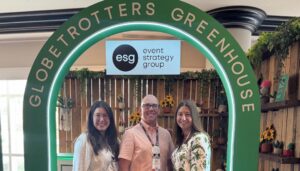
Event Strategy Group Combines Cuddly with Climate Action at CEMA Summit 2025

Philadelphia, Pennsylvania – September 09, 2025 – Event Strategy Group (ESG), a leading agency in B2B event marketing, was among the most highly sought-after activations at this year’s Corporate Event Marketing Association (CEMA) Summit. The agency’s innovative experience zone, “Globetrotters Greenhouse,” captivated attendees by combining whimsical, high-value giveaways with a serious commitment to sustainability.
Attendees—including industry partners and brand-side marketers—were invited into a charming, mock plant store environment designed specifically for busy event professionals. The activation’s central feature was an array of adorable Jellycat® plush plants, a playful nod to the challenges of keeping real plants alive while constantly on the road. Beyond the playful facade, the activation was built on a foundation of sustainability. The “Globetrotters Greenhouse” was
constructed with 90% repurposed and recycled materials by a local Austin company to minimize its carbon footprint. ESG also partnered with One Tribe, an ICROA-certified climate action platform, to calculate and offset the entire carbon footprint of the CEMA Summit. Attendees voted on three different carbon-offsetting projects—from biodiversity conservation in Indonesia to solar power in India—with the winning project, the Rimba Raya Biodiversity Reserve Project, receiving funding.
“ESG’s activation hit all the points to make it memorable and relevant – the eye-catching design was made for social moments, the gamification and Jellycat giveaways made it fun, and the philanthropy angle and usage of sustainable materials gave everyone who engaged a feel-good moment,” commented Jihan Donawa, Sr. Growth Marketing Manager, Swoogo.
The experience was thoughtfully curated, featuring custom-canned cocktails and hibiscus tea served by staff in logoed aprons, a custom Spotify playlist, and a photogenic “forever fresh” neon and greenery wall.
“This was one of my favorite activations at CEMA Summit,” said Meg Fasy, Founder & CEO, FazeFWD, former Board Member and 20-yr. member of CEMA. “ESG always brings a fresh, creative and fun experience to the conference.”
The activation highlighted ESG’s innovative approach to creating engaging and impactful brand experiences. The team received numerous thanks from attendees for their work and for the positive impact the activation had on the event.
“We wanted to bring the same fresh thinking and innovation we bring to every client engagement to our own activation” said Kellie Mayrides, CMP, Client Success Manager at ESG and lead on the project. “Globetrotters Greenhouse was truly a joy to bring together. CEMA Summit 2025 will be hard to top, but we already have our thinking caps on for next year’s conference!”
About Event Strategy Group
Since our founding two and a half decades ago, we’ve produced thousands of corporate events. Massive ones, small ones, and somewhere-in-between ones. Digital. In-person. Hybrid. Regardless of format, events need to move the needle. ESG helps brands accelerate sales cycles and deepen their customer relationships. Find out what getting “it” done for clients means and visit us at www.esg.us.
MEDIA INQUIRIES
Khaner Walker
khanerw@arcsenseconsulting.com
1-919-412-1566
02 Event Strategy Group Celebrates 25 Years of Transforming Corporate Events Into Unforgettable Experiences

Event Strategy Group Celebrates 25 Years of Transforming Corporate Events Into Unforgettable Experiences

Philadelphia, Pennsylvania – May 1, 2025 – Event Strategy Group (ESG), a leading event marketing agency specializing in B2B experiences, proudly announces its 25th anniversary today. Since its founding in 2000, the agency has delivered thousands of memorable events for global brands across the technology, finance, healthcare, and professional services sectors.
“The secret to our success and longevity over the past 25 years has been the talent, creativity, and hard work of every team member here at ESG,” said Renee Scullin, President & Co- Founder of ESG. “Because of their passion, we’ve continually had the growing privilege of working with a diverse range of clients, bringing their visions to life, and making unforgettable experiences.”
“At an event, ‘it’ changes nearly every minute and sometimes every second, but getting ‘it’ done is what we truly excel at,” said Co-Founder Norm Aamodt. “From fully 3D designing an event space, to building a stage, ensuring transportation is on time, and everything in between, this mantra has become our mindset, and I fully believe it’s why we’ve enjoyed the longevity we’ve had.”
Since first opening their doors, ESG has:
- Delivered more than 12,000 corporate events globally
- Worked with hundreds of companies, from start-ups to the Fortune 100
- Expanded sustainability practices across its portfolio
- Grown its team and capabilities, adding over 50 positions in creative, design, planning, event tech, and production
“Thank you to our amazing people, amazing clients, and an amazing community that has enabled us to grow and thrive,” continued Scullin. “It’s been the adventure of a lifetime, and I truly feel like we’re just getting started!”
About Event Strategy Group
Since our founding two and a half decades ago, we’ve produced thousands of corporate events. Massive ones, small ones, and somewhere-in-between ones. Digital. In-person. Hybrid. Regardless of format, events need to move the needle. ESG helps brands accelerate sales cycles and deepen their customer relationships. Find out what getting “it” done for clients means and visit us at www.esg.us.
MEDIA INQUIRIES
Khaner Walker
khanerw@arcsenseconsulting.com
+1-919-412-1566
03 Event Strategy Group Announces Multiple New Hires in Q1 2025
Event Strategy Group Announces Multiple New Hires in Q1 2025

Philadelphia, Pennsylvania – Mar. 21, 2025 – Event Strategy Group (ESG), a leading event agency, today announced the strategic hiring of four new professionals to support its expanding client base and evolving project scopes. The additions bring diverse expertise and strengthen ESG’s capabilities across creative strategy, accounting, administration, and event technology.
“We are thrilled to welcome Kate, Melissa, Jade, Christina, Lia, and Sam to the ESG team,” said Renee Scullin, President & Co-Founder of ESG. “Their diverse backgrounds and proven track records will be invaluable as we continue to grow and deliver exceptional experiences for our clients.”
Kate Burton, Event Manager: Kate brings a wealth of working with Fortune 500 companies in effectively planning and executing brand campaigns. Prior to joining ESG, she spent seven years with Wasserman creating and delivering event and hospitality programs. She received her MS in sport and fitness administration from Florida State University and her master’s in business administration from the University of South Florida.
Sam Ferkler, Event Technology Coordinator: Sam recently graduated from West Chester University of Pennsylvania with a BS in Computer Science and a minor in statistics. In his new capacity, he will join the technology team and oversee systems integrations from event technologies into client systems, website and application development, and more.
Jade Graddy, Senior Creative Strategist: Jade brings a wealth of experience in writing, editorial, content creation, and creative strategy. A global citizen with professional experience on six continents, Jade is passionate about helping clients tell their stories effectively. She previously served as Senior CS Editorial Manager at Shorthand and Communications Consultant at Campbell & Company. Jade holds a BA in linguistics and a minor in human rights from the University of Washington.
Christina Knapper, Accounting Specialist: Christina brings nearly 24 years of experience in accounting across a wide variety of industries and experiences. She was most recently an Accounts Payable Specialist at Norris Furniture & Interiors and prior to then, was a Home Office Accountant at Liberty Property Trust for 20+ years.
Melissa Mulaney, Event Manager: Melissa brings a wide variety of event and marketing experiences to ESG having spent the past decade supporting client initiatives in house. She’s worked on corporate event and marketing teams for RR Donnelley, Vericast, Doosan, and SAB N. America. She graduated from Monmouth University with a BS in business administration with a concentration in marketing.
Lia Togila, Executive Admin: Lia has three years of experience in project coordination and brand strategy, with a focus on driving creative projects to success through innovative problem-solving and audience targeting. She previously worked as a photographer and production supervisor at Philip Gabriel Photography and as a photo editor at Bloomsburg University of Pennsylvania. Lia graduated from Commonwealth University-Bloomsburg with a degree in mass communication with a focus in photojournalism.
“These new hires will play critical roles in supporting ESG’s continued growth and ensuring the agency delivers innovative and impactful solutions for its clients,” continued Scullin. “We remain committed to investing in top talent and providing our clients with the highest level of service.”
####
About Event Strategy Group
Since our founding more than two decades ago, we’ve produced thousands of corporate events. Massive ones, small ones, and somewhere-in-between ones. Digital. In-person. Hybrid. Regardless of format, events need to move the needle. ESG helps brands accelerate sales cycles and deepen their customer relationships. Find out what getting “it” done for clients means and visit us at www.esg.us.
MEDIA INQUIRIES
Khaner Walker
khanerw@arcsenseconsulting.com
1-919-412-1566
04 Event Sponsorships & Maximizing ROI

Event Sponsorships & Maximizing ROI

Sponsorships are a crucial element of the event eco-system for organizers, sponsoring organizations and attendees, alike. When done well, sponsorship activations foster valuable interactions between attendees and your company.
So let’s discuss how you can maximize ROI with your precious event sponsorship dollars, drawing from insights shared by our experts here at Event Strategy Group.
- Don’t Wait to Discuss ROI: It’s essential to define and communicate goals for an event at the outset. Establish how you will measure success — whether through Net Promoter Score (NPS) at the booth, the number of leads gained, RSVPs, or actual attendance figures. Clear internal communication at the start ensures everyone is aligned on the objectives and that you’re measuring the KPI’s that actually matter post-show.
- Focus on the Attendee: Brands have a lot to say to attendees, but ROI means ensuring the right content finds the right people (and demonstrating this exchange happened). Effective sponsorships focus on what will pull attendees to engage with your activation, rather than how to push the sponsor’s sales pitch to them. Strategies such as personalization and gamification can create experiences that will draw attendees in and stick with them after the event.
- Leverage Event Technology: There are myriad options when choosing among event tech, but there are several types we keep coming back to:
- Personalization: Any event tech that enables personalization is one we’re all in on. A great example (and one we’ve pioneered) starts with insights gathered during event registration, that are then analyzed by AI, and both are then combined and used live onsite. Our clients are finding the results here to be a very powerful boost to their ROI.
- Micro Fencing: Digital fencing around targeted areas can notify attendees as they approach specific experiences, adding a layer of engagement and value for sponsors. Adding to this the personalization we mentioned above…you are now speaking our love language!
- Gamifying the Experience: Innovative uses of technology can extend even to your hotel key card! For one engagement, we put a QR code on attendees’ hotel key cards that provided them with daily event challenges and further integrated with personalized text messaging. This direct channel of communication deepened users’ experience with the event app and their curiosity with the brand and their offerings.
- Approach Pay-to-Play Cautiously: Sponsorship offerings should be specific and aligned with the event’s content objectives. Sponsored speaking opportunities can be powerful engagements and can also be disasters, if attendees feel like they are simply sitting through a sales pitch. Too many paid speaking opportunities (say one right after the other) can quickly lead to a disjointed attendee experience they quickly tune out of. Have a clear understanding of what the organization is offering and ensure your content aligns with what the audience is expecting.
Demonstrating and maximizing event ROI can be done – we do it nearly every day! Interested in exploring any facet of the above in more detail? Need a fresh look at at your sponsorships or want to explore how event tech can support them? Reach out to us at info@esg.us.

05 Event Agency Wraps 15th Consecutive Consumer Electronics (CES) Show

Event Agency Wraps 15th Consecutive Consumer Electronics (CES) Show

PHILADELPHIA, PENNSYLVANIA – Feb. 20, 2025 – Event Strategy Group (ESG), a leading event agency, has a long history in supporting Lenovo’s marketing efforts around the globe, and this year is celebrating a 15-year milestone of producing the Company’s CES show.
“We had this idea of taking over a space outside the convention center and turning it into an ‘invite-only,’ destination site for Lenovo’s customers and partners back in 2009,” said ESG co-founder Norm Aamodt. “The idea really worked, the client loved it, and together we have expanded on it nearly every year since. This year’s showcase was one of the largest CES shows we’ve ever produced, and I believe, our combined best yet.”
A lot has happened in the 15 years ESG has been at CES, especially as of late as in-person events continue to have a strong post COVID rebound. The 2025 show was one of the most impactful ones yet. Since starting to produce events at CES in 2010, ESG has seen:
- CES attendees grow by 17.5% from 120,000 attendees in 2010 to 141,000 in 2025
- The launch of connected TV’s, 3D printers, driverless cars, the first wearables, and voice assistants at the show
- Musical acts from Imagine Dragons, to Smash Mouth, Matchbox Twenty, and many more take the Lenovo stage at night
“While we’re renowned for our logistical excellence and boundary-pushing productions, at the core of our relationships is serving as a trusted, creative partner to our clients,” continued Aamodt. “15 years at CES with one client is an incredible testament to the exceptional work our team does and their dedication on behalf of the world’s best brands.”
About Event Strategy Group
Since our founding more than two decades ago, we’ve produced thousands of corporate events. Massive ones, small ones, and somewhere-in-between ones. Digital. In-person. Hybrid. Regardless of format, events need to move the needle. ESG helps brands accelerate sales cycles and deepen their customer relationships. Find out what getting “it” done for clients means and visit us at www.esg.us.
MEDIA INQUIRIES
Khaner Walker
khanerw@arcsenseconsulting.com
+1 (919) 412-1566


06 Event Apps and Emerging Event Tech

Event Apps and Emerging Event Tech

In today’s fast-paced event landscape, technology is revolutionizing how events are planned, executed, and experienced.
Event apps and emerging tech solutions are at the forefront, making lives easier for organizers and attendees alike. Here’s a closer look at why you should consider an event app and what new technologies are shaping the industry.
Why You Should Have an Event App
- Streamlined Event Management
- Centralized Information: An event app consolidates all essential details—speaker information, schedules, venue maps, and more—into one accessible location. This not only reduces the need for printed materials, it also minimizes attendee queries, as they can find everything at their fingertips.
- Data Collection and Analytics: Event apps facilitate data collection and provide valuable insights, allowing you to make informed decisions and enhance future events by having a clear understanding of overall satisfaction and engagement levels.
- Improved Attendee Engagement
- Real-Time Updates: Events often face last-minute changes. An event app makes it easier to communicate updates, ensuring attendees are always informed about time changes, new speakers, relocated sessions, and so much more.
- Personalized Experience: Attendees can create personalized schedules, receive reminders for those sessions, and highlight their profiles (like their LinkedIn) for networking purposes.
- Monetization and Sponsorship Opportunities
- Branding and Ads: Event apps offer numerous branding opportunities, such as splash screens, banner ads, and virtual event booths, providing added value to sponsors.
- In-App Purchases: Attendees can quickly purchase access to specific sessions or events, such as when a new speaker is announced, enhancing their experience.
- Sustainability
- Paperless Solutions: By reducing the need for printed materials, event apps contribute to sustainability efforts, making sponsors happy. Attendees can download presentation materials directly to their phones, promoting additional sharing and exposure.
- Digital Exhibits and Content: Event apps support digital exhibits, reducing the environmental impact of physical materials.

Choosing the Right Event App
Firstly, define the scale of your event and identify app features that are an absolute must (like schedule management, networking tools, venue mapping, etc.). Then focus on attendee experience – decide what type of content you primarily want them to see when they log in. Should it be content rich, brand heavy, or something else? Your goals here will greatly inform the solution you choose.
ESG’s Must-Haves for Any Event App
- Agenda and Scheduling Management: Allow attendees to create personalized schedules.
- Session Reminders: Timely reminders for sessions attendees registered for.
- Real-Time Updates: Ensure accuracy for the entire event with a single source of truth.
- Networking: Facilitate meaningful networking opportunities while at the event.
- In-App Messaging: Enable attendees to communicate easily.
- Gamification: Engage attendees with gamified elements that drive content goals.
- Security and Privacy: Prioritize attendee data protection and privacy.
- CRM Integration: For sales-focused events, ensure integration with your CRM tool.
- Custom Branding: Support flash or HTML coding for brand-heavy events.
While high-budget apps offer numerous features, ensure you only pay for what you need to maximize ROI. It’s about getting the right features bells, than getting all of the bells and all of the whistles. A frequent example is ensuring an app’s existing platform can plug into your company’s CRM – finding exact questions like these and ensuring requisite replies will ensure you’re choosing the one that’s right for you.
Finally, ensure its accessibility and security meets today’s standards. Choose an app that complies with accessibility standards like WCAG and security / privacy standards like GDPR. Attendees and the companies they work for want to ensure both of these boxes are checked.
Adopting the right event app and leveraging emerging technologies can significantly enhance event management and attendee engagement. By carefully selecting features that align with your event’s goals, you can create a seamless and impactful experience for all participants.
Interested in learning more? Watch the entire replay below or send us a specific question about your event, and someone on our team will respond as soon as possible!
07 Registration: More than Data Collection

Registration: More than Data Collection

Registration is the cornerstone of any successful event, but its utility extends far beyond merely signing up attendees. Our event techs at ESG breakdown how you can leverage registration tools throughout your event lifecycle to maximize engagement, streamline processes, and enhance the overall experience.
Expanding the Utility of Registration Tools
- Starting Simply: Effective registration begins with a streamlined registration experience. Participants hate navigating through lengthy forms, so keeping it simple is key. Utilizing magic links can eliminate the hassle of passwords, making it easier for attendees to register. Additionally, ensure that every aspect of your registration site is tested thoroughly for broken links and bugs to avoid any technical hiccups.
- Combining Registration and Event Portals: Creating a unified portal for registration and sponsors can provide significant value. Not only are there cost savings from merging two sites into one, but it also boosts engagement. Sponsors can select their booths, choose sponsorship levels, and upload their branding directly through the same portal. This integration also simplifies your back end data access and ultimately enables advanced reporting, providing real-time insights into registration numbers, payment statuses, cart abandonment, and so much more.
- Extending Throughout the Event Experience: Savvy event agencies and companies are utilizing registration data beyond the initial sign-up, and to great affect in greatly enhancing attendee engagement. Pairing the personalized data gained from registration with an event app and technologies like QR codes, RFID, and Bluetooth can create amazingly seamless engagements for any event. Personalized agendas, location-based recommendations, and real-time messaging based on an attendee’s preferences will automatically turn up the onsite event engagement experience for any brand, and furthered even more by using AI…
- Leveraging AI in the Registration Process: Companies are increasingly using AI to personalize attendee experiences. The data from a short questionnaire (4-5 questions max) that’s tied to client goals can then be used to segment our audiences live at an event. The same event tech then immediately lets our client know who’s walking up to them, helps them tailor their talking points, and customize their pitch. AI can also present tailor-made wayfinding suggestions for attendees while they’re at the event booth. The opportunities here are endless, but when done correctly, begin at the registration process!
Encouraging Attendee Registration
To boost registration rates and minimize drop-offs, consider strategies like:
- Chasing Abandoned Registrations: Use reports to identify and follow up on incomplete registrations.
- Incentives: Offer early bird pricing or enter registrants into a raffle to encourage sign-ups.
- Drip Campaigns: Gradually release information about the event, such as keynote speakers and special sessions, to maintain interest and drive registrations during lull periods.
The registration process is much more than a gateway to your event—it’s a powerful tool that can drive engagement, streamline operations, and enhance the overall attendee experience. By integrating advanced technologies and leveraging AI, you can transform your event into a seamless and memorable experience for all participants.

08 Virtual Events that Deliver Value: A Tech Trek Recap

Virtual Events that Deliver Value: A Tech Trek Recap

The pandemic accelerated the evolution of event technology, pushing companies like ours to quickly adapt, scale, and invest in this booming sector. As we navigated our collective way out of COVID-19, the pendulum swung almost fully back in the opposite direction as attendees were motivated to return to in-person, physical events.
Today, we are finding a true equilibrium – one that incorporates both virtual events and physical ones into our clients’ ongoing event strategy. Virtual events will continue playing a role for brands connecting with audiences, as they offer several advantages:
- Extended Reach: There’s no geographical barrier, allowing broader audience participation from anywhere.
- Content Maximization: Content created for virtual events can be repurposed across social media and other channels – and done so with more ease and speed than in-person.
- Cost Savings: Virtual events are frequently more cost-effective than in-person gatherings.
- Sustainability: Virtual events contribute to sustainability goals by reducing carbon footprint, a growing concern to our industry and our clients’ environmental, social, and governance goals.
- Metrics and Analytics: Virtual platforms provide robust data capture, offering valuable insights into attendee engagement and behavior.
For complex virtual events, the planning process mirrors that of in-person events. Meanwhile, simpler events (like webinars) can be organized swiftly without extensive preparation. At Event Strategy Group, we work with clients to find the right combination of technology and format that aligns with their budgets and objectives.
Audience Expectations and Engagement
Capturing and retaining attention is a universal challenge and audiences expect unique and engaging experiences, whether they’re attending in person or virtually. For digital events, incorporating interactive elements like having a DJ, a wellness activity, or a culinary experience can enhance event attendee engagement and deliver the exact experience a brand is looking for in an effective manner.
Debunking Zoom Fatigue
The concept of “Zoom fatigue” has been widely discussed, but it’s important to recognize that the challenge of engaging presentations and effective speaker coaching exists in both virtual and in-person events. The key is to curate content for the medium to ensure speakers are well-prepared, regardless of the format.
Broadcasting Technologies
Partnering with a company like ESG allows us to select and deploy the right technology for the exact type of attendee experience needed, and integrating it seamlessly within your company’s systems and branding. Our goal is to simplify the technical aspects so you can concentrate on content and communication, mirroring the value proposition of in-person events.
Virtual events are a tactic that continue delivering value and should be strategically incorporated along with an in-person event strategy. Understanding when to deploy each format and embracing virtual as a permanent part of your toolkit going forward will ensure your brand’s event strategy is more impactful and engaging than ever.
09 ESG and Fivestone Studios Intelligently Accelerate AI Journeys for Lenovo’s VIP Customers

ESG and Fivestone Studios Intelligently Accelerate AI Journeys for Lenovo’s VIP Customers

Attendees at Lenovo’s annual innovation showcase, Tech World ‘24, experienced artificial intelligence (AI) in a way few others have been able to thanks to Event Strategy Group (ESG), a leading event agency, and Fivestone Studio’s custom creation of the AI Journey Accelerator. The immersive experience reflects Tech World’s remarkable history of innovation and transformation, and fully demonstrates this year’s theme, “Smarter AI for All.”
With Lenovo’s technology and hardware solutions leading the show, the ESG and Fivestone teams sought to develop a curated experience that matched the event’s main attractions. Enter one of Tech World’s most exciting innovations: the Lenovo Solutions and Services Group’s AI Journey Accelerator, a definitive next-generation digital photo booth experience powered by generative AI.
“We hear about AI all the time, but we don’t necessarily get to interact with it,” said Sarah Babb, Creative Director at ESG. “We wanted to tailor-make an experience that embraces AI to showcase Lenovo technology while telling Lenovo’s full Smarter AI for All story — from solutions and services to infrastructure and devices. We also just wanted our attendees to have some fun! The AI Journey Accelerator is a proprietary solution that checks all three boxes: it combines a set of interactive questions with a Stable Diffusion image generation model to determine where participants are in their current AI adoption process, provides personalized insights and resources, and a one-of-a-kind generative AI portrait—all run locally on Lenovo hardware.”
“This project marks Fivestone’s foray into customer-facing, AI-powered experiences, setting a new standard for interactive technology engagement,” said Fivestone Studios Partner and Executive Creative Director Traylor Woodall. “Most studios are now leveraging AI for ideation and efficiency behind the scenes, but we brought it front-and-center by crafting an immersive branded experience that showcases Lenovo’s processing power while also redefining what a photobooth can be in the digital age. By merging creative AI with user-friendly design, we’ve expanded the creative potential for participants, giving them a tangible, memorable keepsake that blends art, technology, and strategic interaction in groundbreaking ways.”
With more than half of Tech World ’24 attendees engaging with the tool, the AI Journey Accelerator is becoming a permanent feature of Lenovo’s trade show presence moving forward.

Creating the AI Journey Accelerator
To demonstrate Lenovo’s AI processing power in each engagement, the teams had the privilege of harnessing the brand’s industry-leading hardware, running the experience on a Lenovo ThinkStation P8 Workstation. For everyone involved, this ensured seamless local performance in photo capture, AI processing, and image generation.
The team worked with Lenovo to identify five key personas representing unique stages in customers’ AI adoption journeys. For these Investigator, Navigator, Catalyst, Coach, and Achiever personas, designers crafted custom logos and themes aligned with Lenovo’s brand guidelines. Fivestone also offered style options showcasing AI’s creative flexibility, from painterly brushstrokes to futuristic, three-dimensional interpretations.
Understandably, the team’s process for addressing this unique challenge involved exhaustive use of the latest developments in generative AI. For the customized AI photos delivered through the AI Journey Accelerator, Fivestone’s team first ran extensive tests using existing generative AI image systems, as well as custom-built options, to optimize workflows. “The magical part of an AI photobooth is how it interprets the source image by reimagining composition, lighting, and style,” said Justin Eslinger, Director of Creative Technology for Fivestone Studios. “Especially when the expectation is a perfectly branded image on the first try, every time, the main challenges are in consistency and control. Getting everything right requires a lot of testing with a variety of people and environments … and an artistic eye and hand to help sculpt the final result.”
Next, to develop the front-end kiosk application, the team streamlined the development pipeline by using the Unity Game Engine. With its Node.js backend, the finished application manages AI generation requests via Stable Diffusion, marketing email capture, image storage, and customer email delivery.
About Event Strategy Group
Since ESG’s founding more than two decades ago, we’ve produced thousands of corporate events. Massive ones, small ones, and somewhere-in-between ones. Digital. In-person. Hybrid. Regardless of format, events need to move the needle. ESG helps brands accelerate sales cycles and deepen their customer relationships. Find out what getting “it” done for clients means and visit us at www.esg.us.
About Fivestone Studios
Fivestone is an immersive multimedia studio that leverages design, technology and storytelling to create wonder and drive human connection. Drawing strength from five shared cultural touchstones – Honor, Bravery, Vision, Generosity, and Excellence – our groundbreaking multidisciplinary talents passionately resolve giant-sized storytelling challenges using emerging technologies and patent processes. Learn more at https://fivestonestudios.com: What can we help you create?
10 After 24 Years of Partnership, Agency Co-Founders Prepare for New Chapter

After 24 Years of Partnership, Agency Co-Founders Prepare for New Chapter

Agency Boasts 10,000+ Events Produced for Companies Like Lenovo, AMD, and More
Event Strategy Group (ESG), a leading event agency, today announced that Renee Scullin has been named President and Owner effective immediately. Scullin replaces Norm Aamodt, who will continue as an active member of the Company as Co-Founder until transitioning into a future advisory role. Scullin and Aamodt co-founded ESG together more than 24 years ago, and since then have grown the Company into one of the most innovative and widely known event and production agencies with clients all over the world.
Aamodt and Scullin first worked together as event managers during their tenure at SAP America. It was there they discovered their shared passions for bringing ideas to life and tackling new types of challenges.
“It has been and continues to be the journey of a lifetime since we started ESG more than 24 years ago,” said Scullin. “We started with a goal of producing one event per month in April 2000, and today we produce more than 800 events annually and employ a team of 40+ employees all over the world. At the heart of our success has been turning ideas into moments that captivate audiences, owning the countless logistics that go into every single engagement, and serving as a trusted creative partner for clients huge and small.”
Scullin played a pivotal role in keeping the Company going throughout several adversities and growing it during the pandemic while the rest of the event industry ground to a halt. She led their renewed investment into virtual and hybrid offerings to meet the evolving business climate and as a result, significantly increased the number of ESG’s new customers.
ESG will continue this path of continued growth from its Philadelphia-based headquarters and with this transition, will become a Woman-Owned Business pending future certification.
“We are committed to growing our employees’ careers – 90% of whom are women – and our presence in the communities they’re located in,” continued Scullin. “We celebrate being a woman-owned business that’s run by women daily, and the pride each of our employees takes in this next chapter of our journey. I cannot wait for what the next 24 years have in store for ESG!”
About Event Strategy Group
Since our founding more than two decades ago, we’ve produced thousands of corporate events. Massive ones, small ones, and somewhere-in-between ones. Digital. In-person. Hybrid. Regardless of format, events need to move the needle. ESG helps brands accelerate sales cycles and deepen their customer relationships. Find out what getting “it” done for clients means and visit us at www.esg.us.
11 4 Things Keeping Event Profs Up at Night…Other than AI

4 Things Keeping Event Profs Up at Night…Other than AI

As the year winds down, we brace ourselves for the inevitable deluge of “Trends for 2024 in the ______ Industry” articles. While I suppose you could put this post into that category, I prefer to call it “Four Things Keeping Event Profs Up At Night…Other Than AI”
I spend most of my time speaking and meeting with event marketers and these topics come up again and again.
Content/Format
There is a genuine interest in re-thinking what is being communicated and how it is delivered. Brands understand that audience demands have changed, and we’re excited to see a willingness to take risks. Attendees are even accepting of some missteps if they are made in an effort to deliver compelling content in an engaging (often shorter) format. Leaning on “what we did last year” is a dangerous strategy. Looking ahead, we’ll be tasked with finding the optimal way to deliver content to our audience from event to event and session to session.
Data
Anecdotes from the sales organization just don’t cut it today. Events make up a higher percentage of marketing budgets than ever before and with that comes increased scrutiny. Management expectations are direct: either demonstrate value or that event spend will be allocated elsewhere. Consider this a shift from ‘nice to have’ to ‘must have’.
One of my colleagues often asks a great question as we kick-off event planning – what needs to change in the attendee from pre-event to post-event? And if we’re going to move that needle, what metrics are we going to use?
Access to the right data is critical to establishing a credible link between budget and return. If you don’t have a plan for data capture, analysis and delivery for every engagement, cue the insomnia.
Sustainability
Corporate governance is pushing sustainability initiatives, and events are an easy target. Up to this point, we’ve seen a lot of lip service paid to sustainability in our industry, only to be quietly walked back if those measures negatively impact the budget.
Increasingly though, we’re seeing decisions made up and down the supply chain with sustainability as a meaningful criterion. Recently a global marketing leader at a tech firm confided improvements in sustainability standards are part of her performance metrics. If this isn’t yet on your priority list, it’s coming.
Community
Once upon a time, an event was a singular engagement where the brand told the audience what it wanted them to know. Today, an event is just one touchpoint in the ongoing conversation between a brand and its customers (or prospective customers). It’s also where attendees connect and engage with each other.
Survey after survey, we consistently hear that peer-to-peer networking is a primary driver for event participation. And like it or not, people are going to talk about your brand and your products. In the absence of a curated community, there are plenty of forums to fill the void, but probably not in the way you would prefer. Event agendas with ample space for networking and sessions that facilitate meaningful connections within your audience have become essential.
Events are now widely considered one of, if not the, most powerful marketing tools in a company’s arsenal. The key to success in 2024 and beyond will be a willingness to evolve our strategies and a relentless drive to provide the utmost value to our attendees.
This article originally appeared on the Meeting Professionals International Philadelphia Area Chapter blog in December 2023.
12 Ah-Ha Moments from CEMA Summit 2023

Ah-Ha Moments from CEMA Summit 2023

I’m Kellie Mayrides, Client Success Manager for Event Strategy Group. I’ve worked in the events industry for 20 years and joined the ESG in summer 2022. My role includes a little bit of everything – proposal creation, new client onboarding, event management, and marketing.
I was recently a first-time attendee at CEMA Summit, the premier gathering of corporate event marketers in the country. Here’s a round up of my top takeaways:
Demystifying Data
Data can be intimidating for those of us who don’t consider ourselves “numbers” people and it’s easy to think of data collection and analysis as the domain of the most tech savvy among us. But three of the sessions I attended made it feel infinitely more accessible.
The Data Hero’s Journey, run by ITA Group, presented a framework for identifying the right data to meet event goals at various points during the event lifecycle. From budgeting to content creation to post-event analysis, we asked:
What questions do we need to answer?
Example: How do we make sure the content at our event is relevant and useful to attendees?
What kind of data can help us answer those questions?
Examples: Hot topics in the industry, challenges attendees are facing, new technologies affecting the industry
How can we source this data?
Examples: Conduct a survey of past and potential attendees and sponsors, use AI to aggregate and analyze recurring topics in industry publications, Competitive conference agendas
How can we use the data to support decision making?
Examples: To create tracks or themes across sessions, to evaluate and select possible speakers
By breaking the process into bite-size pieces and allowing us to brainstorm within a small group, the process of data collection and analysis suddenly felt more accessible and, dare I say it…fun?
The exercise also got us to think beyond post-event survey data, which let’s be honest, is often where our data journey starts and ends. Our minds were opened to all the moments before and during an event when data can be illuminating.
At their session, Success by the Book: How to Develop KPI’s with Metrics That Matter, Jon Wolff of Lenovo and Joe Federbush of Evolio used Lenovo’s booth at the National Retail Federation Big Show as a case study and shared these best practices:
Weight your KPIs. Ranking your KPI’s in order of importance can not only assist in pre-show budget decisions, but it can also help you distill post event metrics into a clear and concise summary for internal stakeholders.
Use a mystery shopper to evaluate booth staff at competitor booths and your own using the same set of questions for a true apples-to-apples comparison.
Leverage AI to help you analyze raw data from your event. Nearly everyone is new to AI, so we shouldn’t be afraid to experiment – you may end up with new and unexpected insights.
And finally, in a session called Six Truths for Innovative Event Strategies run by StoryCraft Labs, we learned that people are willing to share emotional data if they feel it will be used responsibly. One exercise used emojis to track how we felt during different points of the event. I love this as an alternative to your typical survey question and because it’s such as easy ask of your attendees that you could track changes from pre-event to post event and in between.
Redefining Creativity
Another big takeaway came from keynote speaker Natalie Nixon, who underscored creativity’s evolving significance in generating business ROI. Nixon urged us to:
- Seek out what she called “creative abrasion” by bringing diverse sets of stakeholders together for ideation and feedback on possible ideas and solutions.
- Embrace improvisation and experimentation within your organization. When people are part of the improvement process, they are more likely to buy in to testing new concepts.
- Explore beyond the familiar to spark fresh ideas. For example, send your team to a conference outside your industry to gain new perspective.
Moreover, she emphasized that creativity is a skill set that you can grow with practice and workers that are able to leverage that skill will provide the most value to their organizations in an era of increasing automation and AI. As event marketers, we sit squarely in this nexus of creativity and ROI, and I like the idea that one begets the other.
Optimizing Session Length
Everyone who came to CEMA Summit is used to sitting on the event organizer side of a conference. My final takeaway was borne out of the opportunity to simply be an attendee.
Every session I attended included relevant content and most of the speakers were dynamic and engaging, but I felt a little bit like Goldilocks. The sessions where someone was talking at us often felt a bit too long, while the more hands-on workshop-style sessions that allowed us to talk with our fellow attendees never felt long enough.
It got me thinking…how we can get session length just right?
There’s been a lot of chatter in the industry about reducing the number of traditional keynote and panel sessions in conference agendas. After all, one-way communication can easily be replicated in a webinar. And while I’m not suggesting we eliminate these formats altogether, I would argue that these sessions needed to be shorter and punchier. An ideal length might be 20-30 minutes instead of 45-60.
I had a conversation with Nick Borelli, who led a session on The Power of Generative AI in Event Marketing, and he told me he identifies just one main goal for any talk he gives. For that session, it was simply to make people less afraid of and more willing to use AI to augment their human intelligence and hard work.
In contrast, if you’re going to give people a chance to think through solutions to real problems they face and collaborate with fellow attendees, err on the side of giving more time. The Data Hero’s Journey, for example, was an hour, but if it had been more like 90 minutes, I think we all would have been grateful for more time to work through the exercises.
Similarly, the hands-on aspect of Six Truths of Innovative Event Design was great, but between the cacophony of 3 facilitators trying to talk to us at different stations and 2 different exercises to experience at each one, it felt rushed. This was a shame, because I think there was a lot of rich learning to be had in that room. I almost felt like that session could have been broken into 3-6 shorter sessions spaced apart.
Keynote speaker Julie Williamson paused her remarks one point and invited us to talk with the person next to us about a time when we had to adjust our plan to execute our strategy. She had a hard time getting us all to quiet down so she could continue with her talk, which I think is further proof that we wanted to spend more time talking to one another.
The Power of Community
Lest that last bit read as a criticism of the conference, I can assure you it is not. In fact, if the problem is too much great content, it’s not a bad one for CEMA to have on its hands.
The conference was full of thought-provoking ideas and concepts and I left feeling lucky to be a member of this incredible community. Our collective knowledge and experience are unbelievably powerful and act as a multiplier when we share it with one another.
13 From Dubai to Frankfurt: Insights from GDP Connection and IMEX

From Dubai to Frankfurt: Insights from GDP Connection and IMEX
Hi, I’m Kim Ringhoffer! I’ve been with Event Strategy Group for 5 years and I’ve worked on programs as varied as a Harry Potter World Experience in Orlando, Florida to a President’s Club in Bali, Indonesia. My passion is creating high-end VIP experiences across the world.
I recently had the opportunity to attend Global DMC Partners’ Connection in Dubai and IMEX in Frankfurt, Germany and here are a few of my top takeaways!
Family Matters
The line between work and family time is blurring more than ever. Allowing plus ones and even children on business trips is increasing motivation to attend programs.
One idea I found notable was separate adult-only and family-friendly incentive programs, where qualifiers would choose the option that suits them best. For programs that do allow children, touches like branded kids menus and kid-friendly activities or entertainment areas at evening events were encouraged.
This all aligns with the bleisure travel trend we’re seeing across the industry. According to a survey done by IHG Hotels in 2022, 60% of US respondents planned to add leisure days to a business trip in the next 12 months and 54% of business travelers said bleisure supports their work-life balance in a BCD Traveler Wellbeing survey.
Sustainability Takes Center Stage
Sustainability was a hot topic at both conferences. The central question: what does sustainability really mean and how can we accomplish it? In Dubai, a guest speaker from Purpose Net Zero talked about how to reduce event emissions, specifically, and offered their site as a place event professionals can use as a resource for strategies and information.
My favorite 1:1 appointment at Global DMC Partners Connection was with the DMC of the Nordics. They were not only some of the nicest people I met at the show, but I was blown away by their event options and their focus on sustainability and fully green venues. It’s now my mission to plan an event there!
The Power of Small Moments
One session that really hit home for me talked about how people are looking for something that will ultimately change them in some sense. Statistics were cited that programs that were able to accomplish this in some way, were the highest rated among attendees.
Whether it’s facilitating meaningful conversation among our attendees or offering an opportunity to give back through a charitable activation, finding ways for attendees to make a difference in their lives, or the lives of others, is something I’d like to intentionally build into future events.
14 Go Medium or Go Home: Brands Leaning Towards More Targeted Events

Go Medium or Go Home: Brands Leaning Towards More Targeted Events

We recently created a beautiful CES activation for our friends at Lenovo. The world’s largest consumer tech show, a longtime January tradition, returned to Las Vegas on a grander scale this year. To me, though, it was cause for both comfort and pause. Some people — many of them with skin in the game — will tell you that the events industry is back to normal. I am not one of them.
This year’s CES attendance was a big rebound from 2022 but it still came in below the numbers from way back in 2010, let alone its pre-pandemic peak in 2019. The CES new tech announcements were fantastic as always (check out the Lenovo YogaBook 9i if you haven’t already) but there weren’t as many people there to gasp when the veil came off each product.
After a busy 2022 spent all over the US and abroad, my ESG team estimates that in-person
attendance at live events continues to lag somewhere between 65% and 80% behind pre-pandemic levels. The reasons are well-documented. Some attendees are hesitant to travel. Costs to businesses are up. Hotel, venue and food/beverage contracts are less flexible while attendee/sponsor registration is happening much closer to event dates. Incredibly, sponsorships costs have not budged, leaving brands with the prospects of paying the same or more for quite a bit less. I think some in the events industry take it for granted that brands will continue to bear this burden. Again, I’m not so sure.
A Time for Scrutiny
The beginning of the year is inevitably a time for taking stock. Companies are tweaking strategies, setting goals and, in many cases, tightening belts. This is the moment to dig deeper on what’s happening and scrutinize your own event portfolio/spending in light of it. This is precisely the right moment to ask:
- What are your company’s goals for this year?
- Do these goals acknowledge evolving realities or are they stuck in a pre-pandemic mindset?
- What events are you slated to host or attend and what is their scale?
- Are these events likely to have a measurable impact on your key objectives?
- Given new realities, are these events designed to provide maximum value to attendees?
That last question is key
Those in the business of organizing or attending big events are right to wonder how people are feeling and where the “normal meter” is set right now. It’s quite clear that people have undertaken a radical post-pandemic re-examination not only of their work but of their lives. Do they still crave the adrenaline rush of the mega-event or are they more comfortable with something more scaled down? Can they get what they need without attending at all? Your company darn well better be listening to what your audience is saying and designing an event portfolio that matches those needs. I took the temperature on my LinkedIn page and heard some thoughtful things back from a few of my connections.
A New Model
Sure, it’s a small sample size but those quotes are in line with everything else I’ve been hearing. My sense is that, for many, mega-events have outlived their usefulness. People are speaking volumes by not returning and the only companies that are seeing the same ROI are the ones that have markedly reworked their content strategy. The majority of attendees want something different, something special. I think people are willing to engage when they see something that matters to them. They are filtering out the noise and focusing on what matters.
The draw for smaller events? They tend to be better for relationship-building and they foster a sense of belonging. No one likes selling—they need collective problem-solving. Large industry events are still important to Lenovo, says Jon Wolff, Events Manager for the company’s Solutions & Services Group, but brands must adapt to the current climate. “Many attendees are becoming more selective about which events they attend in person. We are focusing in part on smaller, more targeted events. For example, we created something called the Lenovo Lounge. It’s a VIP event series, a more intimate experience with roughly 40-50 key individuals. These are invite-only conversations that focus on timely, specific topics and provide a valuable opportunity for networking.”
For those of you whose brands might be mulling issues like these, I offer five pieces of advice:
1. Talk to your audience and see what they want. Tailor your event strategy accordingly. Make it easy for people to engage — they’ve been through a lot. Choose venues closer to where people live and keep the events short. Ensure that the content on the agenda is absolutely best served in person.
2. Quality, not quantity. Focus on getting the right people — not the most people — into the room and then be sure to meet their most pressing needs.
3. Build community. See what you can do in between events to keep people engaged. Consider customer-led calls on a monthly or quarterly basis.
4. Adopt a more risk-averse event strategy. We’re calling it “Go medium or go home!” Several of our clients have openly discussed doing this as of late and there’s some wisdom in taking this approach.
5. Shift to hosted events. One of our clients was disappointed with the results of a sponsored, third-party event in 2022 so they are taking over the show, creating a customer conference for a legacy product and a potential road-show format for a new market they’re looking to break into.
We at ESG are not show organizers — we’re builders, creators who are constantly evolving our methods based on the latest trends and truths. Our allegiance is to the client and no one else. So, yeah, sometimes we get to speak ugly truths that no one else dares speak. My ugly truth is that it’s time for us to make peace with our mega-event past and reimagine what brings people the most value. It’s the least they deserve.
15 The Science Behind Storytelling

The Science Behind Storytelling

Crafting a compelling, genuine story as a central theme is one of the best things you can do for the success of your event. This statement might be bold, but it’s based on more than just anecdotal evidence — we’ve got science to back us up! Read on to learn why storytelling at events is one of the most effective communication tools you can use to reach your most valuable audiences — even in virtual or hybrid formats.
Every brand has a story to tell
Emotion is attention, in that connecting with your audience on an emotional level will significantly increase attention span and recall. So how do you make those connections? The answer lies in storytelling. Every brand has a story to tell, and live events are the perfect venue to tell them — a group of mostly like-minded individuals, waiting with bated breath to hear what you have to say during the keynote? It’s the salesperson’s dream.
To be clear, story ≠ sales pitch
This is the most common misstep we see made during presentations, as the two are easily confused. However, whereas salespitches are often laden with facts and statistics, maybe with a customer testimony thrown into the mix, stories are focused on painting a robust picture with context and examples. If a sales pitch is a 2D animation, a story is a virtual reality simulation. Both are valuable, both have their place. But where sales pitches appeal to our logical brains (often combined with a healthy dose of skepticism), stories appeal to our emotions — and are incredibly memorable, persuasive and captivating as a result.
The miracle of mirror neurons
Many factors contribute to why storytelling is so effective at grabbing and retaining attention, but at the heart of it is some unique biology called mirror neurons. These special brain cells fire not only when we perform an action, but when we observe someone else perform that same action as well. That is, our brains light up in the same places and release the exact same chemicals when we watch someone do something, as if we were doing it ourselves.
On a base level, this is part of what accounts for human empathy. We all know the feeling of witnessing someone wipe out, wincing vicariously through their pain. We’ve all watched delicious food being prepared and eaten on TV, our mouths watering as if we were there in the kitchen with the chefs. On a more applicable level for events, we can learn to leverage this naturally occurring, miraculous phenomenon when communicating our most valuable information to key audiences.
Storytelling is effective because mirror neurons don’t just rely on visual cues — they respond incredibly well to spoken word as well. When our mirror neurons fire while listening to a compelling (read: emotional) story, our brains release a mix of dopamine, oxytocin and cortisol; the hormones linked to memory and information processing, social bonding, and our bodies’ alert systems, respectively. Basically, we’re hooked. Psychologists call this experience “narrative transportation” — the feeling where the world falls away and we are completely engrossed in the story we are witnessing. How’s that for audience retention?
Make it memorable
The narrative model has been proven to aid in recall, and humans have been using stories as memory devices since the beginning of time. Think back to grade school and your favorite mnemonic device. It’s much easier to remember My Very Excellent Mother Just Served Us Nine Pizzas, then say, the precise order of planets in our solar system. After images and scenes, the next thing our brains remember is emotion, and after that, dialogue and facts. So if emotion is attention, and narrative is memory, then an emotional narrative makes for one whammy of a presentation!
Make it memorable
With powerful storytelling at your event, you can begin to turn curiosity into brand loyalty, and brand loyalty into the coveted brand advocacy. Bottom line: stories humanize your event. They give it a personality and speak to your audience on a deeper level than traditional corporate rhetoric. Want your audience to remember something? Hit them in the feels. You have the power to persuade, increase engagement, inspire action, and influence behavioral changes in your audience — all through storytelling.
P.S. Need help with crafting your story? We can help. Contact us today.
16 Script Writing for the Screen

Script Writing for the Screen

With more events being transitioned to an online format every day, quality script writing is now more important than ever. The screen is the new stage, and with this scenery change comes a different writing and communication style as well. Whether for keynotes, kickoffs, or really any type of live online presentation, content delivery needs to be adapted to yield the best results. Instead of being in a large room filled with hundreds or even thousands of other attendees, your audiences are now most likely sitting by themselves with only their laptops in front of them. The content writing strategies you use to earn and keep their undivided attention is critical to program success, so we’ve outlined our top tips:
One on one
It’s important that the presenter understands that, unlike speaking in front of a large group where you need to be aware of the size of the audience and venue, people are watching the presentation on a screen, and most likely alone. If your content allows it, formatting delivery in the style of an interview, or having the speaker address a small studio audience can help them give their best presentation.
Small screen, big picture
On a stage in a live setting, the presenter must be aware of physical space, body language and movement — it’s all part of communicating effectively. But in a video presentation, the producer and editor select the shots that best communicate key content and what’s most important, directing the audience on how to watch. This allows the presenter to be more focused on tone and delivery of content and message. In this way, the production team becomes just as important as the speaker themselves in effectively delivering the message, and the team must be unified in their techniques.
Conversation, not keynote
Writing for the spoken word is very different than writing for print. And writing for video is closer to writing dialogue than writing a speech for a large, in-person audience. Think about a more relaxed intimate conversational approach. “Personalize” the script to make it feel more comfortable for both the presenter and viewer. Short, simple sentences make it easier for the viewer to follow and comprehend information. Generally, people tend to be more colloquial when speaking and communicate in phrases, not long, grammatically correct sentences.
Pauses are helpful. Use ellipses and even over-punctuate to help indicate pacing (this is especially useful if reading from a teleprompter or cue cards and for rehearsal).
Underlining key words or phrases for emphasis or inflection helps communicate what’s most important and underscores how you want the audience to “hear” it (teleprompter or cue cards).
Read your script out loud for clarity, pacing and time. Repeating or rephrasing something important can be useful for emphasis and clarity.
Hooks and teasers
Audiences have been trained how to watch television, especially programs with a familiar anchor person or host. There are common, conversational phrases that help set up what’s about to be said, or signal what’s important, or transition from one topic or segment to another, or to summarize/close a presentation. Here are a few suggestions and examples to give you an idea how you might think about the style of your script and where the presentation fits into the overall program.
Open with a question, challenge, or reflective thought:
• “Have you ever…?”
• “This is a bit unusual, but…”
• “What should we…?”
• “Can we…?”
• “There are times when…”
Acknowledge present circumstance:
• “The last few weeks have been…”
• “I know how you feel, we all feel the same way…”
• “Dealing with uncertainty can be…”
Leads, set-ups, and recaps (use names if appropriate):
• “Here’s what we can expect…”
• “Let’s take a look at…”
• “You want to know…”
• “Coming up…”
• “Later in the program, (name) will… but first…”
• “So where does that leave us…?”
• “Let me be clear…”
• “What’s most important…”
• “That’s it from here… back to you, (name)…”
Personal and professional
Video in this familiar format is very effective for communicating and retaining information. Comfortable for both the presenter and audience, it can be inspiring and motivating as well when it has a positive and confident tone.
In uncertain times, people want to feel confident in their leaders. For viewers invited into this close-up, personalized conversation, there is an anticipation of authenticity, of an honest straightforward exchange. For the presenter, it’s an opportunity to connect on a personal, emotional level to build confidence and trust. A simple, focused script for this format can have a powerful impact.
17 Five Things to Include for a Successful Sales Kickoff Agenda

Five Things to Include for a Successful Sales Kickoff Agenda

While you are planning your sales kickoff agenda, there are key components to keep in mind. An ideal sales kickoff agenda lays out a creatively woven tapestry of great speakers, engaging breakout sessions, well-timed networking opportunities and effective team building exercises — all focused on precisely what your salespeople need. Easy, right? (Fear not, we’re here to help).
Five critical areas of focus for your kickoff agenda should be:
- Top-performing sales success stories
- Sales development training
- Product training
- Networking
- A high-level review of the previous year
Sales success stories
Recent research has shown that only 21 percent of company executives feel as though sales reps have relevant examples to share with them on sales calls. This not only hurts your company’s reputability, but could also prevent your sales reps from closing the deal. How to fix this?
Instead of the traditional kickoff model of a business exec giving a single keynote presentation, leverage the heavy-hitting presentation model of storytelling by way of your top performers. Have your top salespeople share their own experiences, tips and stories of successful sales in a live panel discussion with room for questions. The benefits of this are two-fold: top performers will feel that their efforts are recognized and appreciated, and all sales reps will receive relevant, valuable information to apply to their own sales techniques.
Storytelling is a powerful tool in connecting with and retaining your audience’s attention — whether they are your customers or your own employees. Make sure your speakers use engaging presentation techniques to keep the attention of their fellow sales reps with our top recommendations. Once the event is over, you can turn the success stories that were shared during kickoff into case studies that can be distributed among your staff for future reference.
Development training
A sales kickoff event is the perfect time to schedule some tactical sales training sessions. The most successful sales reps never stop learning the newest techniques, so giving your staff valuable training will help them grow as individuals and within your team. Additionally, try providing training in areas that are more than just sales such as marketing, increasing engagement, and hard skills that are job-specific. Mixing in some soft skills, such as effective communication techniques, listening skills and empathy will go a long way in sales negotiations. If your kickoff event is held over multiple days, try splitting up the sessions so that each day has a session and each session matches up with your kickoff theme.
Product training
An exceptional salesperson could probably sell a product they have no idea how to use or operate. However, even the best salesperson will be an even better seller if they grasp the concept of the product. A sales kickoff meeting is a great time to train your staff on the newest product updates, features and expansions. Spend some time going over the existing product line, and how it can be utilized for your ideal customer during breakout sessions. Explain what has been updated, and how your customer will benefit. If there are new features, walk your team through how to use them. If your sales line has expanded, show off the new products.
We recommend breaking up the training sessions into chunks no longer than 30 minutes, if only just to get up and stretch for five minutes before sitting back down to continue the session. On average, people only actively listen during seven out of every 60 minutes of a presentation. Out of those seven minutes spent actively listening, of what is heard is forgotten within 72 hours. Breaking up substantial chunks of technical information will help to increase your salespeople’s retention. From the company whose core brand values include having fun, we recommend making the training sessions as fun as possible. Life is short! Vary up the subject matter, and if possible, include audience participation.
Networking
Networking is vitally important in both your sales process and your kickoff meeting. Having the time to network and build relationships within your organization and team can help to bolster morale and strengthen the bond your team has with each other. Networking, especially among entry- and middle-level employees and upper management, can help to share the vision of your sales goals and fortify the relationships that your team has with the company. This is an opportunity for your sales reps to make connections with people they may not regularly see, mingle, and share ideas with. You never know who someone might meet that will help them close a deal!
Previous year review
Showcase how well you did last year, and also make sure to mix in those areas with room for improvement. This is also the time to point out your competitors and how they’re doing, as well as brainstorm how you can beat them (or leave them in the dust). Product developments and reinforcement of sales goals will help to align the meeting content with your overall business objectives. At the end (of your review, and of the kickoff meeting), make sure you reinforce the theme and what everyone has learned with new learning materials, handouts and questionnaires. Videos of the sessions and recaps of the key points from each panel or breakout will help to keep everything top of mind as your salespeople and company head into this new sales season.
Are you ready to deliver a high-impact and original sales kickoff experience? Let our professionals at ESG help create lasting impressions, memories, relationships and connections in one fantastic event. Contact us today to learn more!



